2023
connecting
Solo show
Galerie Mark Müller
Galerie Mark Müller
20/1/23 – 18/3/23
Zürich
Zürich

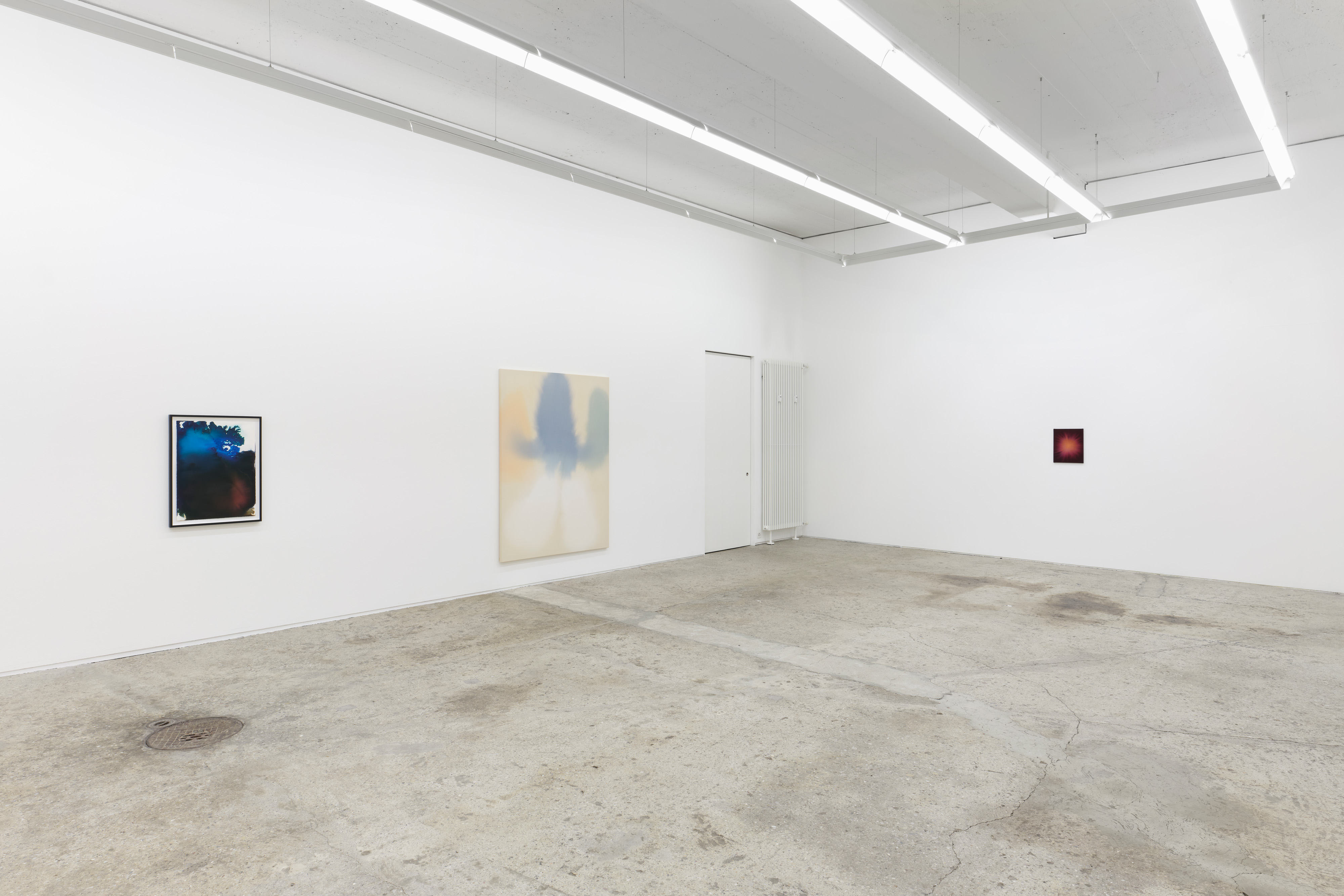
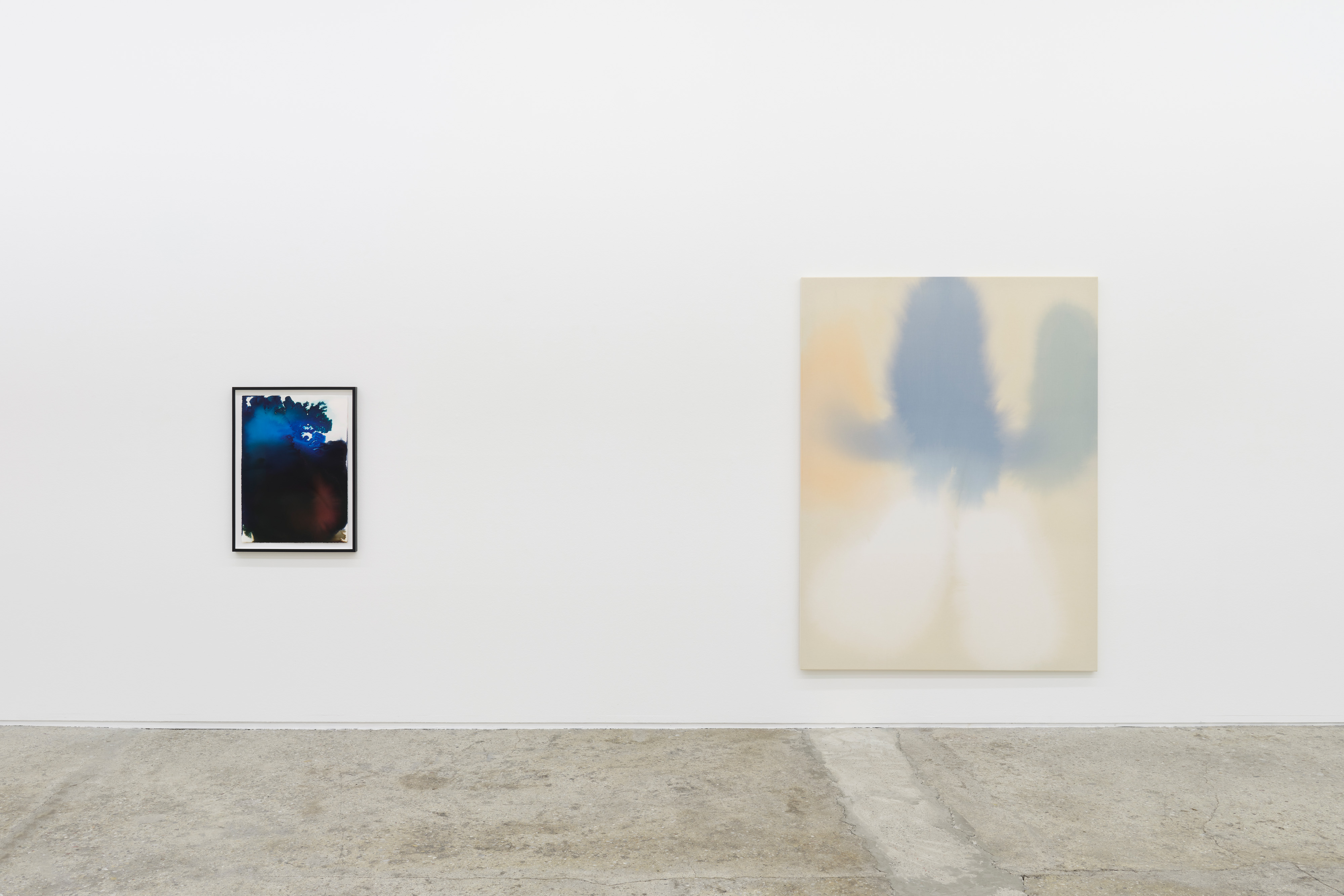

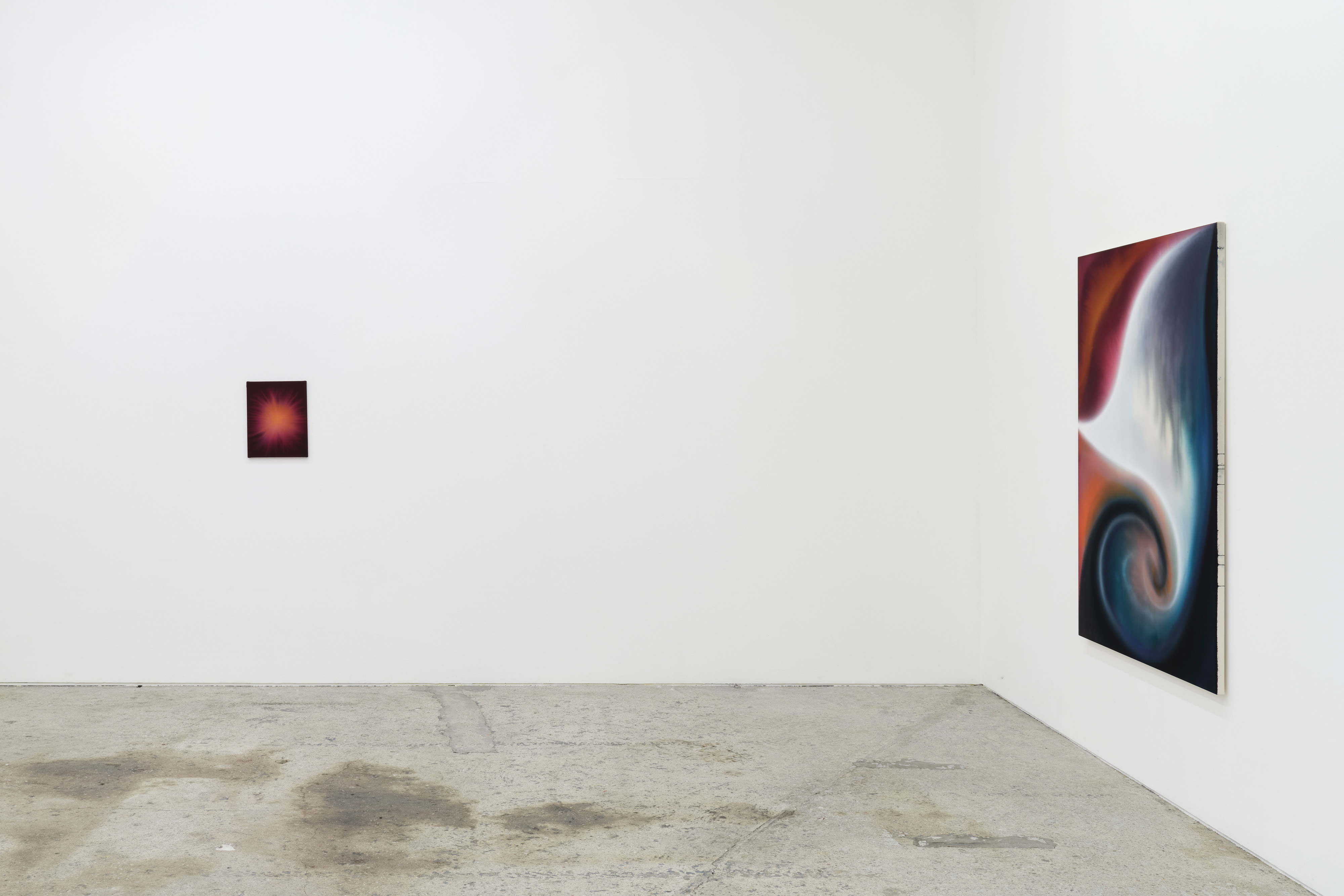
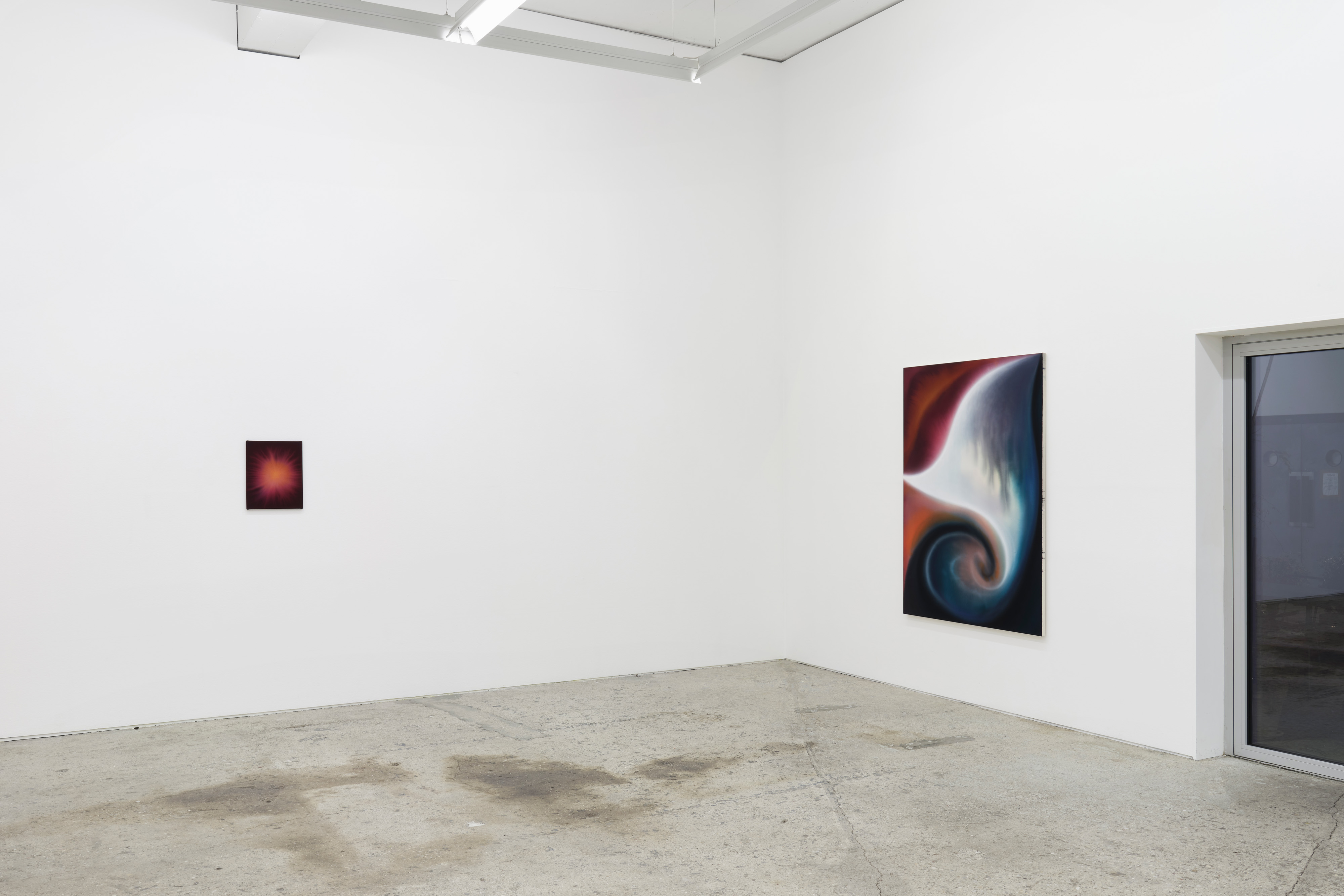

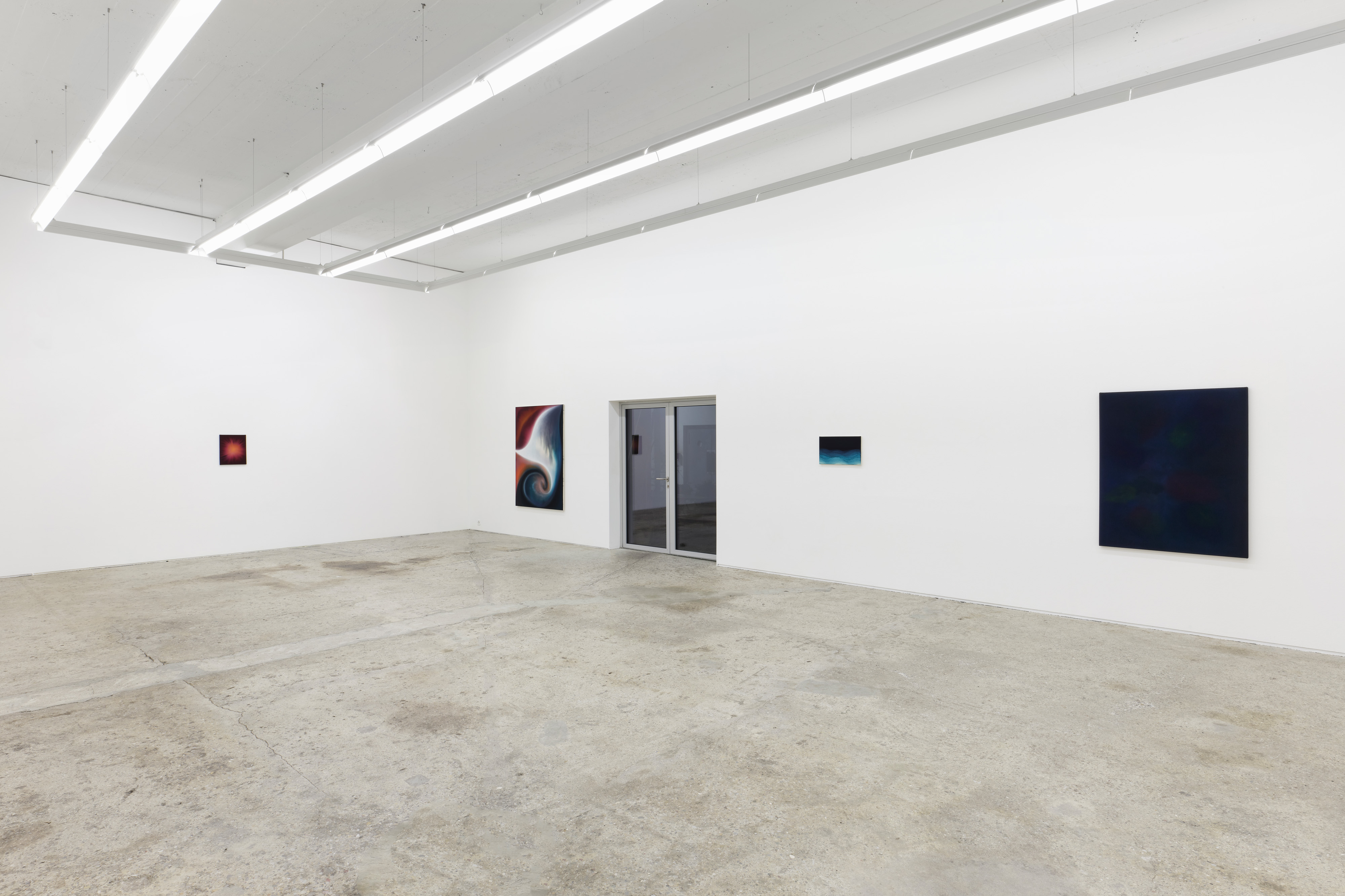



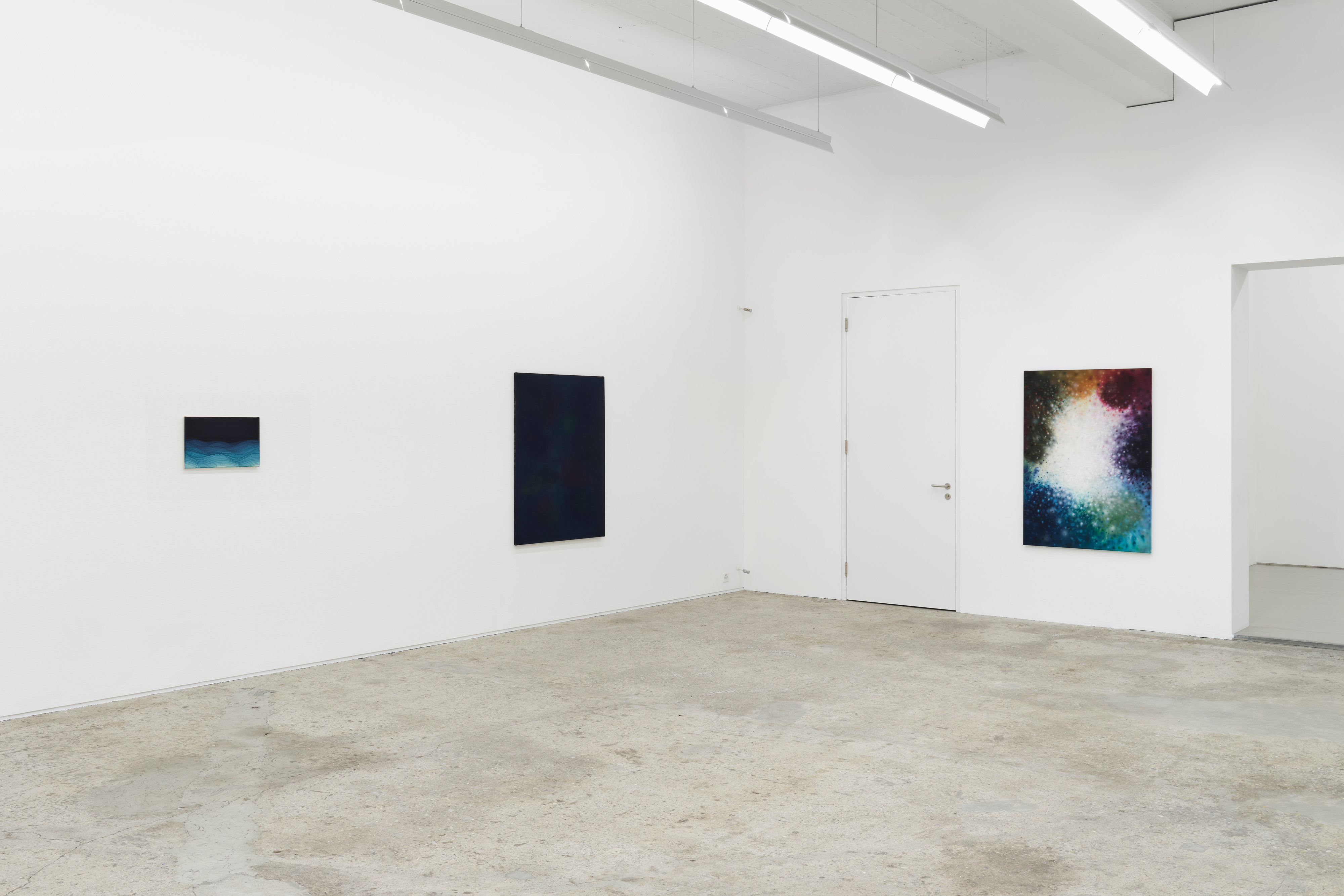
What a paradox to call an exhibition of abstract painting connecting, when the Latin root of the word ‘abstraction’ speaks of detachment. This apparent contradiction is even more striking if we consider that the works chosen by Giacomo Santiago Rogado for the Mark Müller Gallery belong to different series and are thus dis- connected from their original contexts.
Yet, it is precisely in these cognitive dissonances that the true meaning of the exhibition lies. Only here, in the distances and discrepancies between the artworks on display, we are able to appreciate the poetics that connect Rogado's extensive research. Here the artist unfurls his very own understanding of ‘abstraction’ as an intimate connection with the audience, a dialogue with the other, without ever imposing but proposing, never affirming but always questioning.
The visual language of connecting is devoid of spatio-temporal coordinates and recognisable objects. The works depict evocative shapes that appear as particles, fluids, elementary life forms, or planets, stars, galaxies. In these compositions, fantasies of extraordinarily small and extraordinarily large worlds converge to express fundamental properties. We thus perceive a sense of inconsistency and transparency, interpenetration and overlap, consonance and resonance.
Rogado's reduced and sophisticated style offers a welcome alternative to the visual saturation of our time. As we follow the delicate
Yet, it is precisely in these cognitive dissonances that the true meaning of the exhibition lies. Only here, in the distances and discrepancies between the artworks on display, we are able to appreciate the poetics that connect Rogado's extensive research. Here the artist unfurls his very own understanding of ‘abstraction’ as an intimate connection with the audience, a dialogue with the other, without ever imposing but proposing, never affirming but always questioning.
The visual language of connecting is devoid of spatio-temporal coordinates and recognisable objects. The works depict evocative shapes that appear as particles, fluids, elementary life forms, or planets, stars, galaxies. In these compositions, fantasies of extraordinarily small and extraordinarily large worlds converge to express fundamental properties. We thus perceive a sense of inconsistency and transparency, interpenetration and overlap, consonance and resonance.
Rogado's reduced and sophisticated style offers a welcome alternative to the visual saturation of our time. As we follow the delicate
juxtapositions between shapes, the careful layering of colour, and the constant search for depth, matters of virtual realities, high resolution and augmented reality move further into the distance.
Discart the superfluous in order to find the essential – this is the poetic truth that Rogado presents to us. His art’s graceful language reveals a desire to give voice to transcendence, to let it speak, with all its murmurs and silences.
"All this without looking you will see..."
Pablo Neruda once said to his friend. It applies perfectly to Rogado's work as well, aiming right at its most profound meaning. While Rogado has certainly chosen the arduous path of abstraction, exposing himself to the risks of intellectualism, didacticism or insignificance, he wanders along it implementing Neruda's words to his own world of images: How can painting show the invisible?
A paradoxical question to which one can only give paradoxical answers. Rogado, an avid pupil of Zen philosophy, is well aware of this. According to the ZaZen school, meditation can be summarised in one single expression: 'just sitting'. Similarly, while painting Rogado does nothing more than... ́just painting’. There is no forethought, no project, and no pre-constituted knowledge, the practice is carried out with balance and perseverance as a "paradoxically blind exercise of painting".
And what this exercise, above all else, bears witness to is an act of faith in everything we can see only by briefly closing our eyes.
Luca Libertini
Discart the superfluous in order to find the essential – this is the poetic truth that Rogado presents to us. His art’s graceful language reveals a desire to give voice to transcendence, to let it speak, with all its murmurs and silences.
"All this without looking you will see..."
Pablo Neruda once said to his friend. It applies perfectly to Rogado's work as well, aiming right at its most profound meaning. While Rogado has certainly chosen the arduous path of abstraction, exposing himself to the risks of intellectualism, didacticism or insignificance, he wanders along it implementing Neruda's words to his own world of images: How can painting show the invisible?
A paradoxical question to which one can only give paradoxical answers. Rogado, an avid pupil of Zen philosophy, is well aware of this. According to the ZaZen school, meditation can be summarised in one single expression: 'just sitting'. Similarly, while painting Rogado does nothing more than... ́just painting’. There is no forethought, no project, and no pre-constituted knowledge, the practice is carried out with balance and perseverance as a "paradoxically blind exercise of painting".
And what this exercise, above all else, bears witness to is an act of faith in everything we can see only by briefly closing our eyes.
Luca Libertini
2022
Reality Blue
Solo show
Bernhard Knaus Fine Art
Bernhard Knaus Fine Art
7/1 – 9/3/22
Frankfurt
Frankfurt
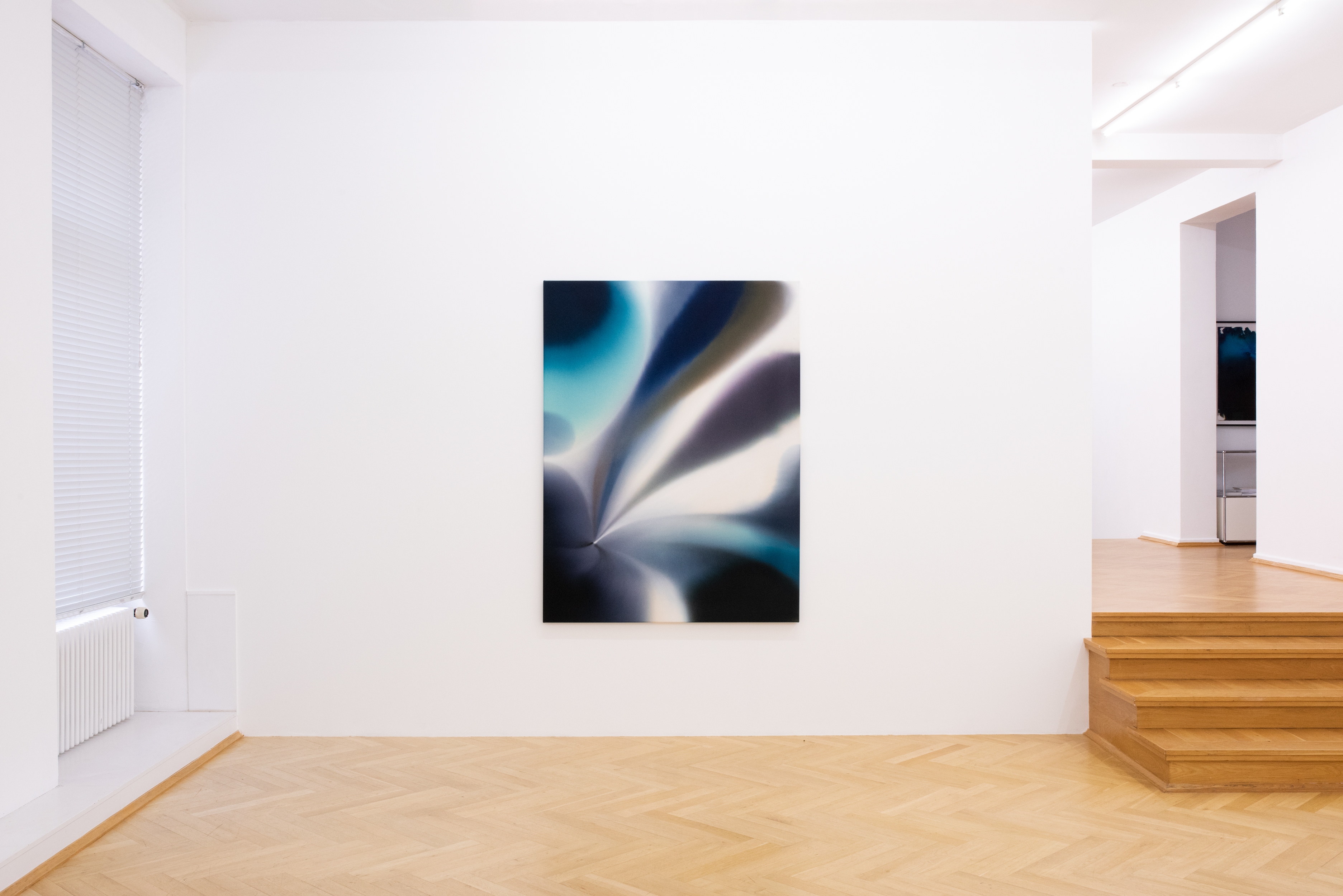
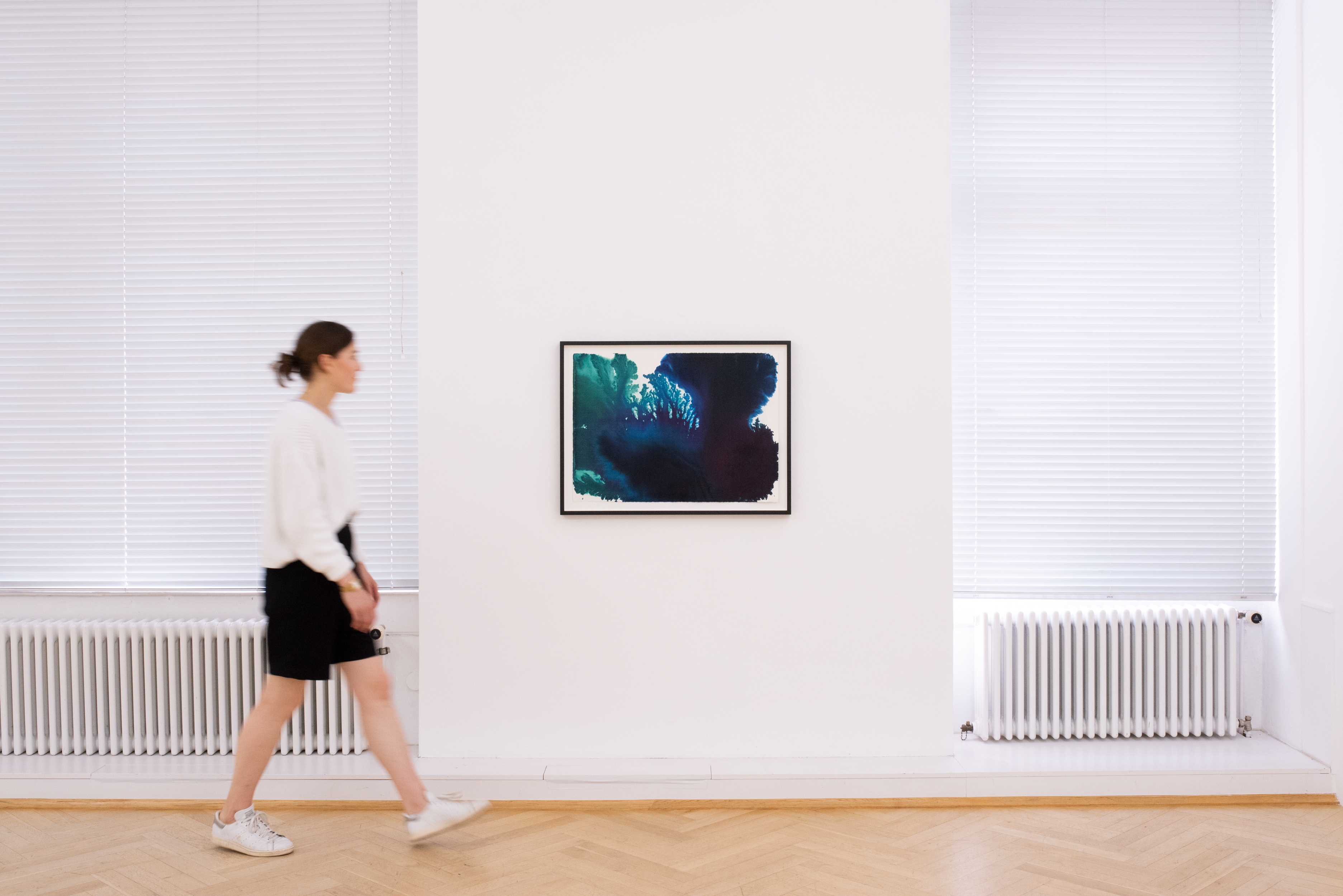
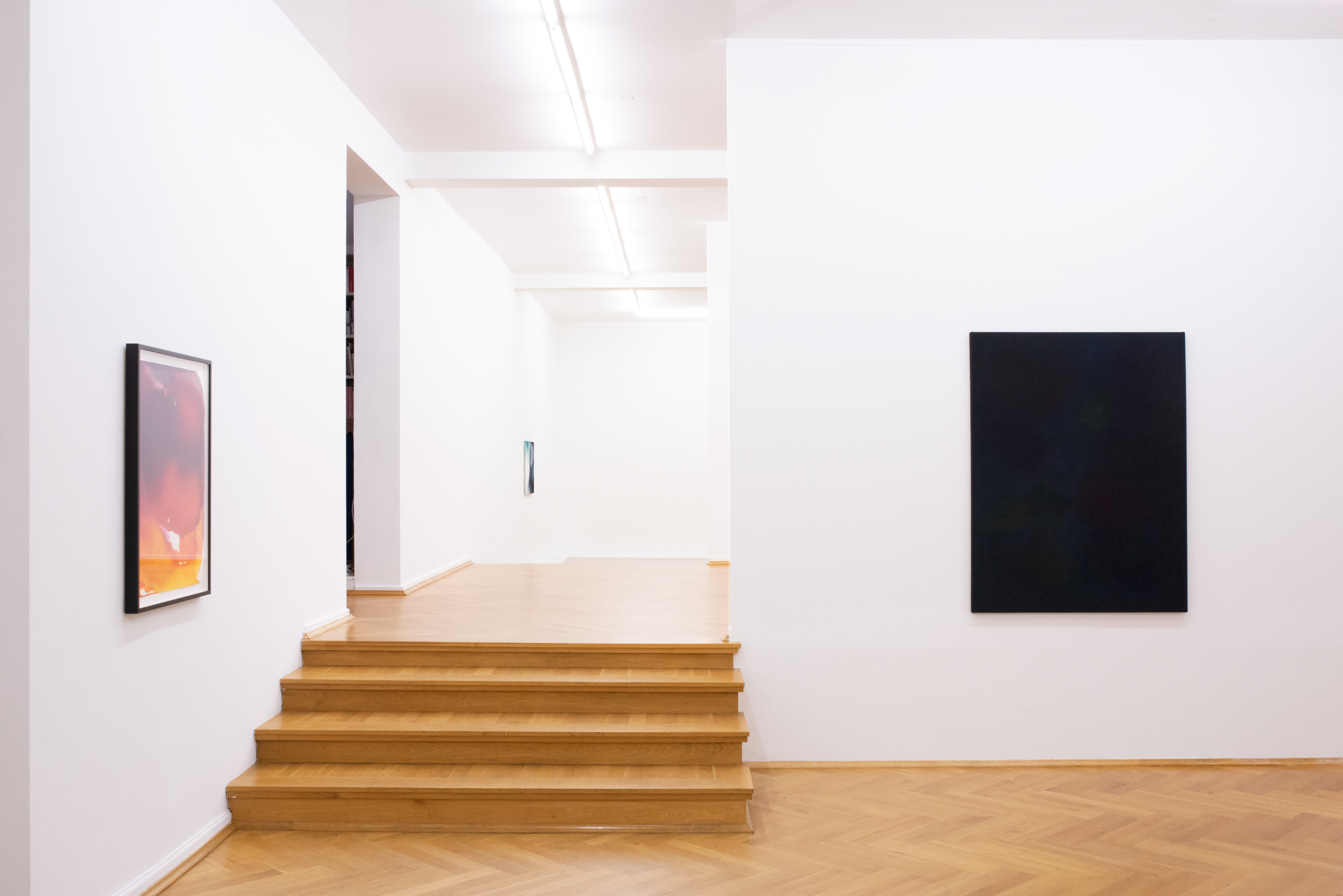
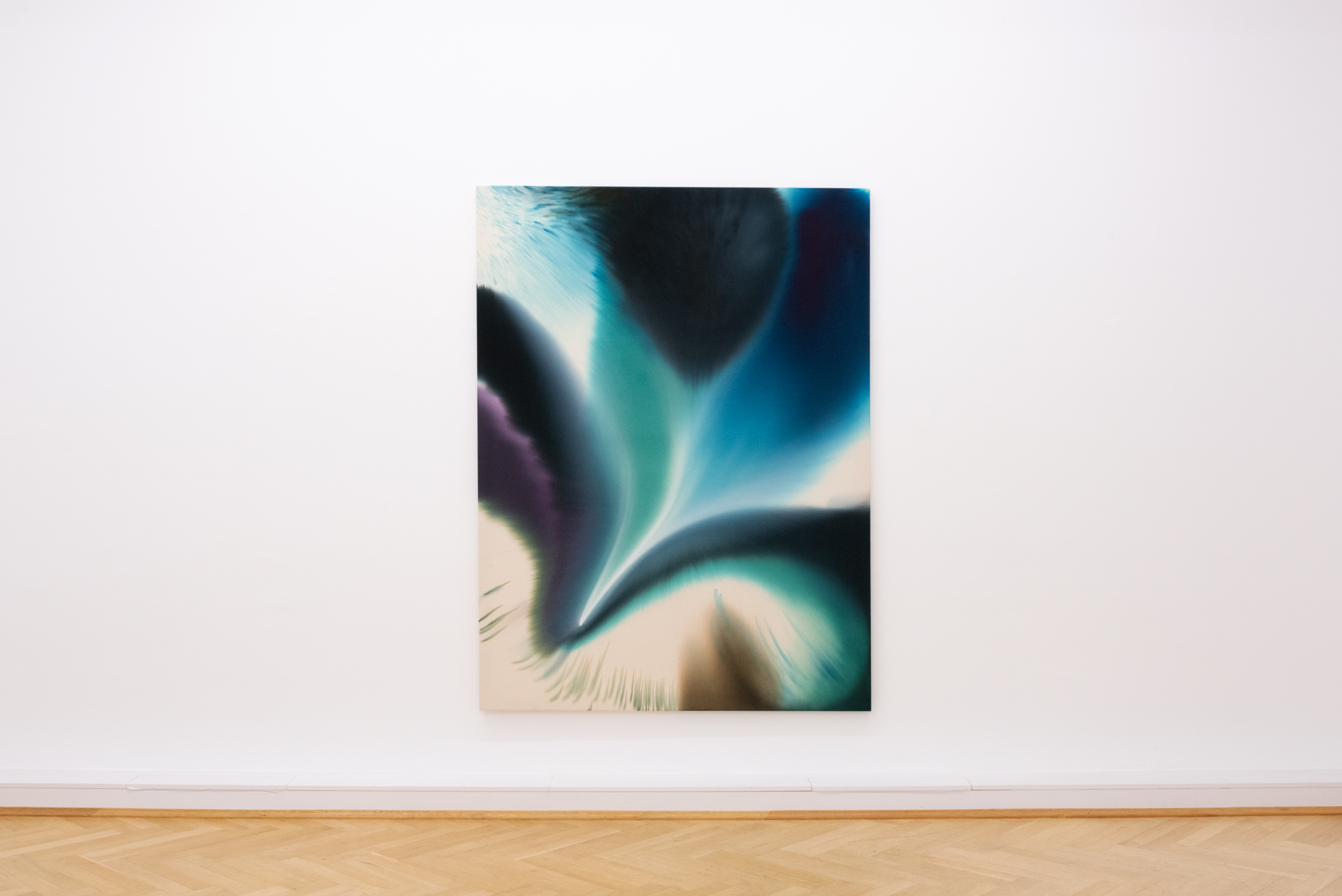

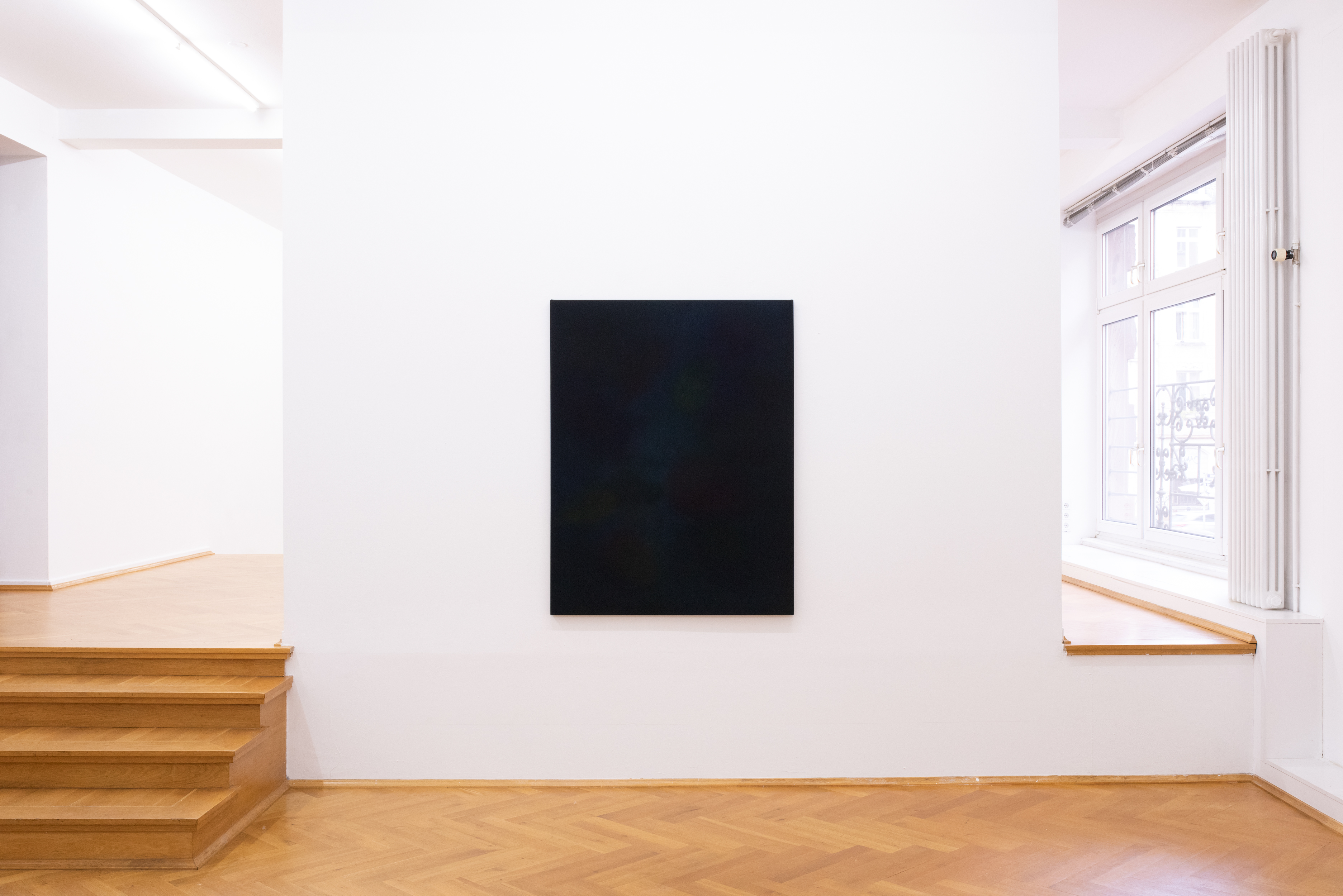

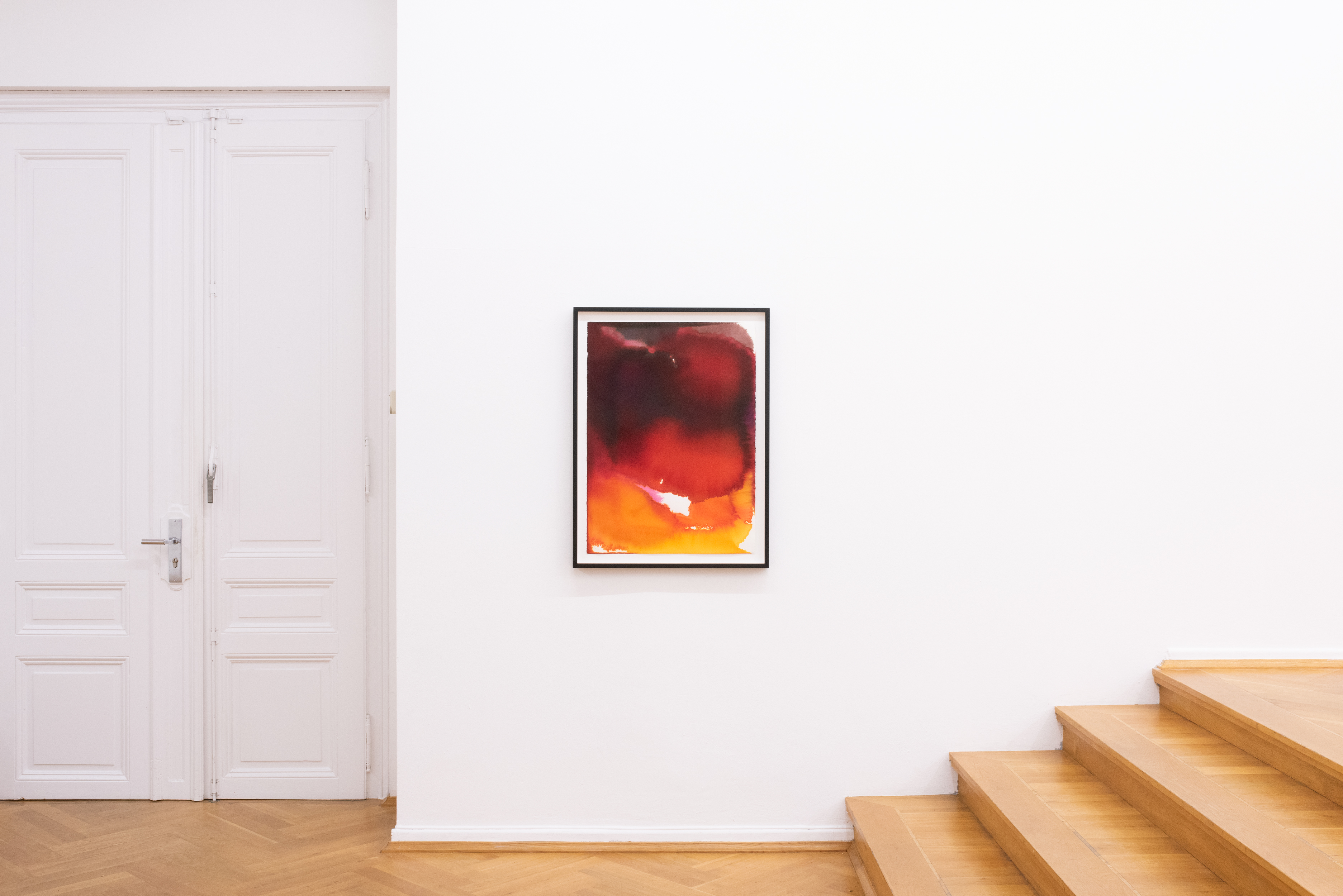
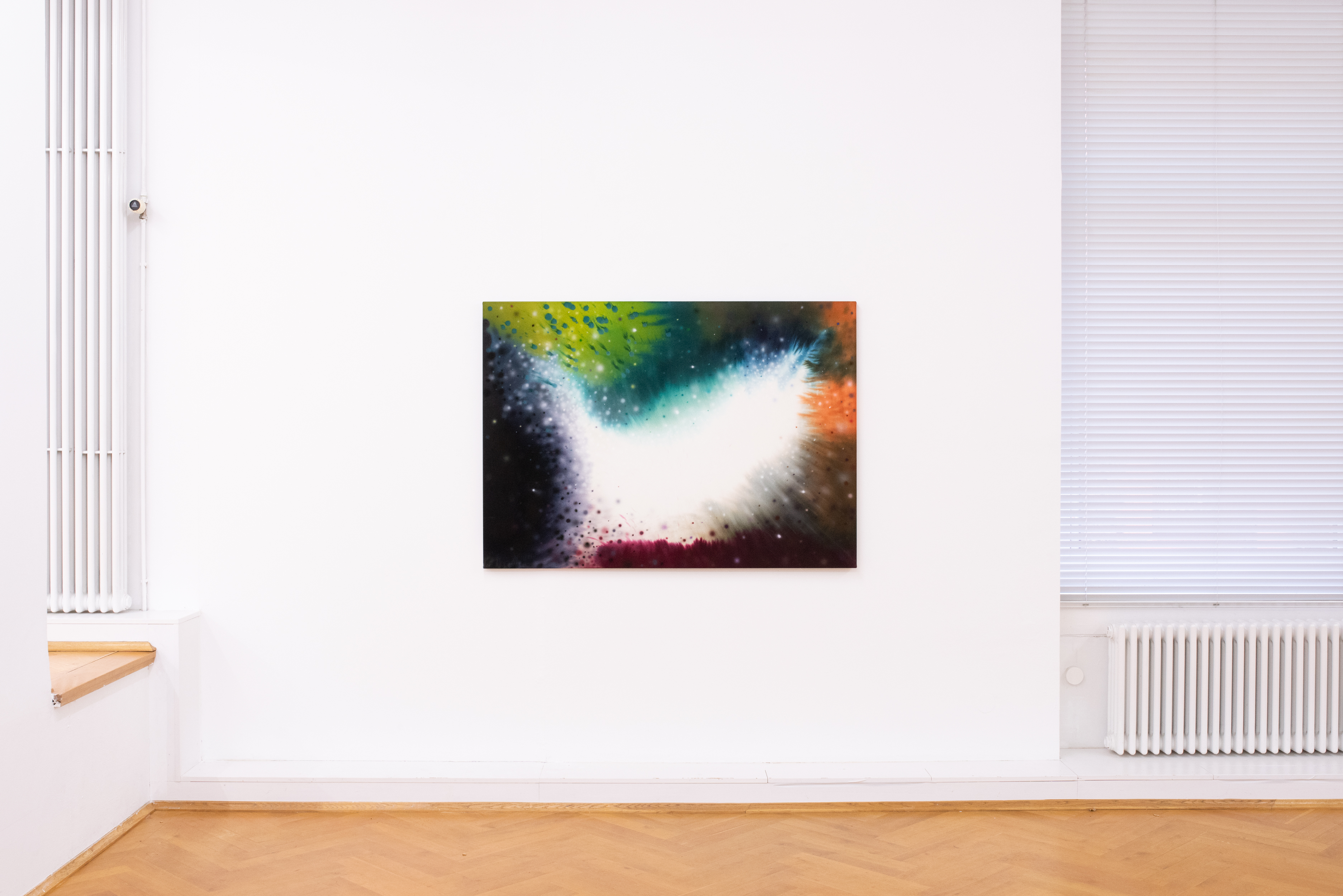
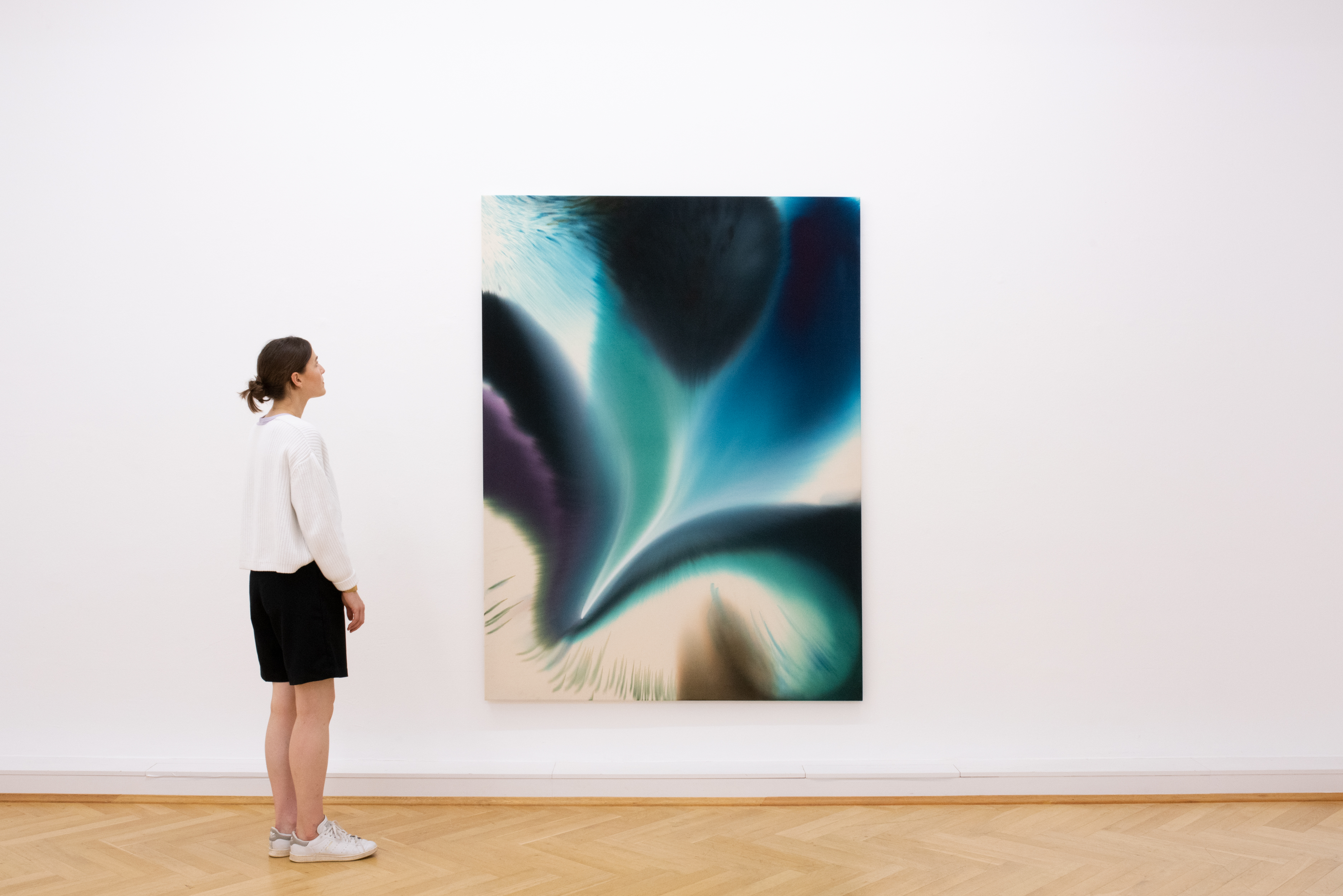
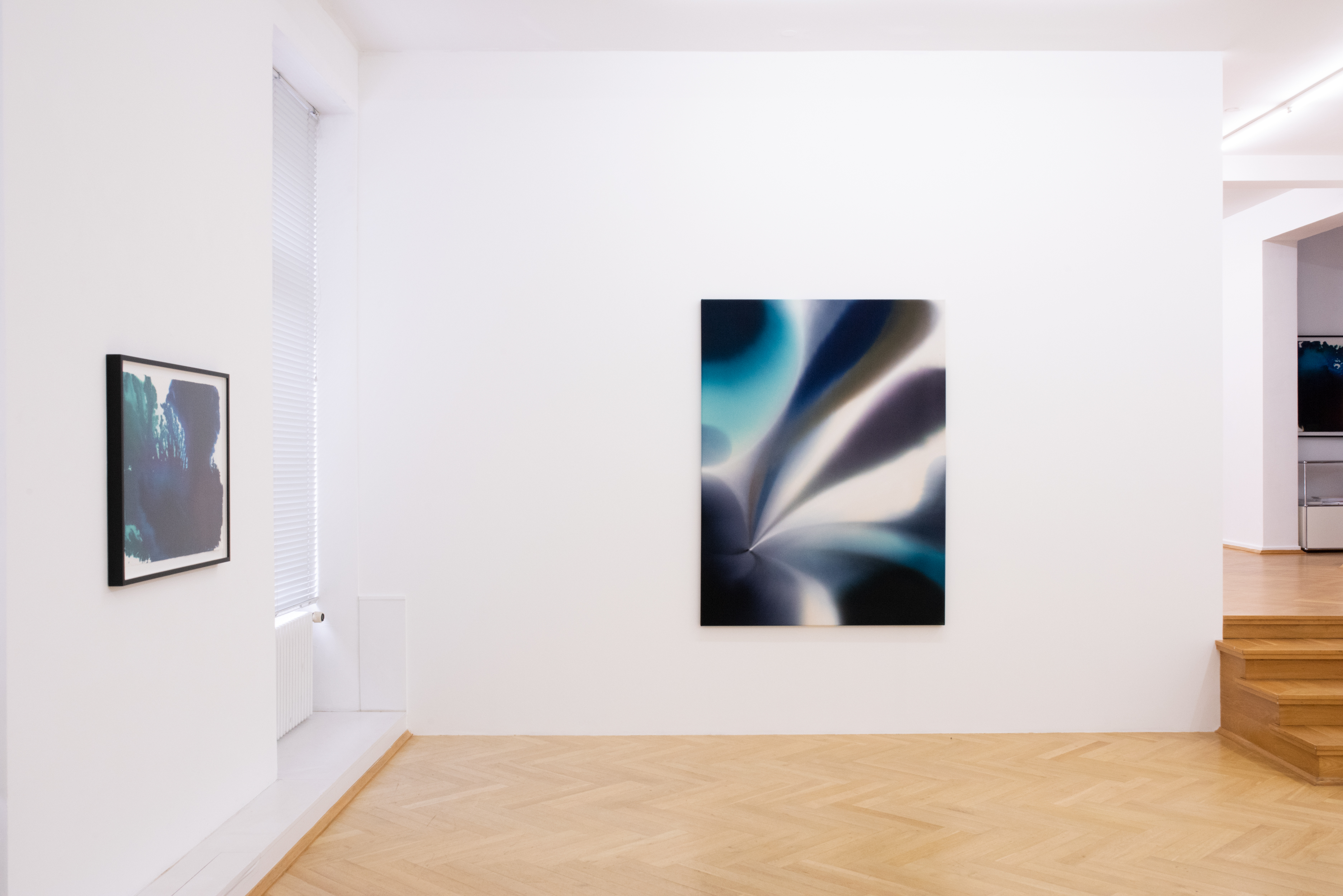
Blue is water, sky, infinity or, according to Yves Klein, "the invisible becoming visible". In the latest works by Swiss artist Giacomo Santiago Rogado, the distance between color and its perception dissolves. The intuitive comes to the fore. Rogado's third solo exhibition at Bernhard Knaus Fine Art brings together these recent works that play with the impossibility of perceiving things as they really are.
Close your eyes and imagine an ocean. In all likelihood, the color blue predominates in this image. Conversely, blue is automatically associated with largely positive qualities and things like tranquility or the sea. Blue also often plays a central role in the paintings of Giacomo Santiago Rogado, where the artist combines the depth of the color with the rest of the color spectrum in harmonious compositions. This harmony, based on the artist's meditative way of working, is transmitted to the viewer. Colors become figures on the canvas, which make contact with the subconscious and set meditative processes in motion.
In his latest paintings, Rogado continues developments that were already touched in earlier works. The artist thereby transfers the act of painting in parts to the materials of his works: cotton, pigment and water. Circular forms emerge, traces of color movements settle into the canvas or onto paper. The works from the series "Intuition" show an interplay of light and darkness. Both components seem to arise from similar centers, which, however, cannot be firmly located.
Nuances from turquoise to midnight blue, from crimson to bordeaux red, enter into connections and spread further in the pictorial
Close your eyes and imagine an ocean. In all likelihood, the color blue predominates in this image. Conversely, blue is automatically associated with largely positive qualities and things like tranquility or the sea. Blue also often plays a central role in the paintings of Giacomo Santiago Rogado, where the artist combines the depth of the color with the rest of the color spectrum in harmonious compositions. This harmony, based on the artist's meditative way of working, is transmitted to the viewer. Colors become figures on the canvas, which make contact with the subconscious and set meditative processes in motion.
In his latest paintings, Rogado continues developments that were already touched in earlier works. The artist thereby transfers the act of painting in parts to the materials of his works: cotton, pigment and water. Circular forms emerge, traces of color movements settle into the canvas or onto paper. The works from the series "Intuition" show an interplay of light and darkness. Both components seem to arise from similar centers, which, however, cannot be firmly located.
Nuances from turquoise to midnight blue, from crimson to bordeaux red, enter into connections and spread further in the pictorial
space. There is something mysterious about this flow of forms and colors. It almost seems as if higher forces were at work in its creation. And this thought is not so far-fetched, because Giacomo Santiago Rogado's works release emotional forces in the viewer, who becomes one with the paintings and consequently to a certain extent with the artist himself.
“The painter is you, the painter is me.” These words by the Zen monk Seigaku Higuchi could not describe more aptly the effect of Rogado's paintings, the intuitive-expressive bonds between the viewing eye, the painting and its painter.
Affective, meditative, contemplative - this is how the encounter with a painting by Giacomo Santiago Rogado can be described. However, the artist leaves it up to the viewers which emotions are triggered by looking at his works. In German, the word "Betrachtung" (observation) stems from „Achtung“ which can be translated as both paying attention and respecting something or somebody. The verb „betrachten“ then describes a mutual exchange, in which one can get to know one's environment, but also oneself, better. In current times, in which the concept of mindfulness seems to be overused by the media, but still has its appeal in contrast to the everyday oversaturation by diverse impressions, it is more important than ever to reflect on where attention flows. If one understands Rogado's work "Thrust", for example, as an invitation to reflection and follows it, one receives new impressions of one's own and a common reality. The invisible possibly moves into the field of vision.
Michelle Heyer
“The painter is you, the painter is me.” These words by the Zen monk Seigaku Higuchi could not describe more aptly the effect of Rogado's paintings, the intuitive-expressive bonds between the viewing eye, the painting and its painter.
Affective, meditative, contemplative - this is how the encounter with a painting by Giacomo Santiago Rogado can be described. However, the artist leaves it up to the viewers which emotions are triggered by looking at his works. In German, the word "Betrachtung" (observation) stems from „Achtung“ which can be translated as both paying attention and respecting something or somebody. The verb „betrachten“ then describes a mutual exchange, in which one can get to know one's environment, but also oneself, better. In current times, in which the concept of mindfulness seems to be overused by the media, but still has its appeal in contrast to the everyday oversaturation by diverse impressions, it is more important than ever to reflect on where attention flows. If one understands Rogado's work "Thrust", for example, as an invitation to reflection and follows it, one receives new impressions of one's own and a common reality. The invisible possibly moves into the field of vision.
Michelle Heyer
2021
constant change
Solo show
Kunsthalle
Kunsthalle
21/8 – 3/9/21
Luzern
Luzern


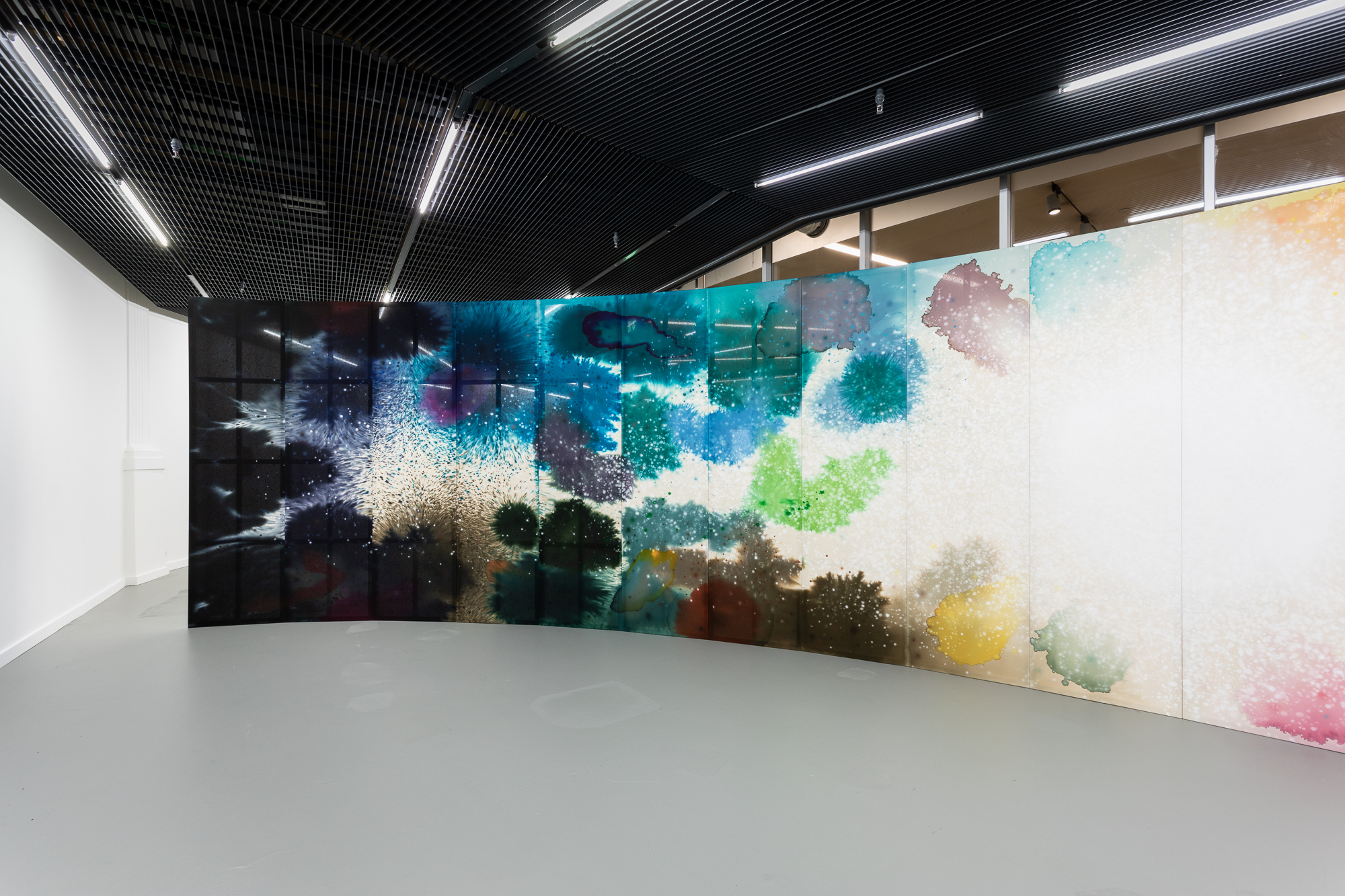
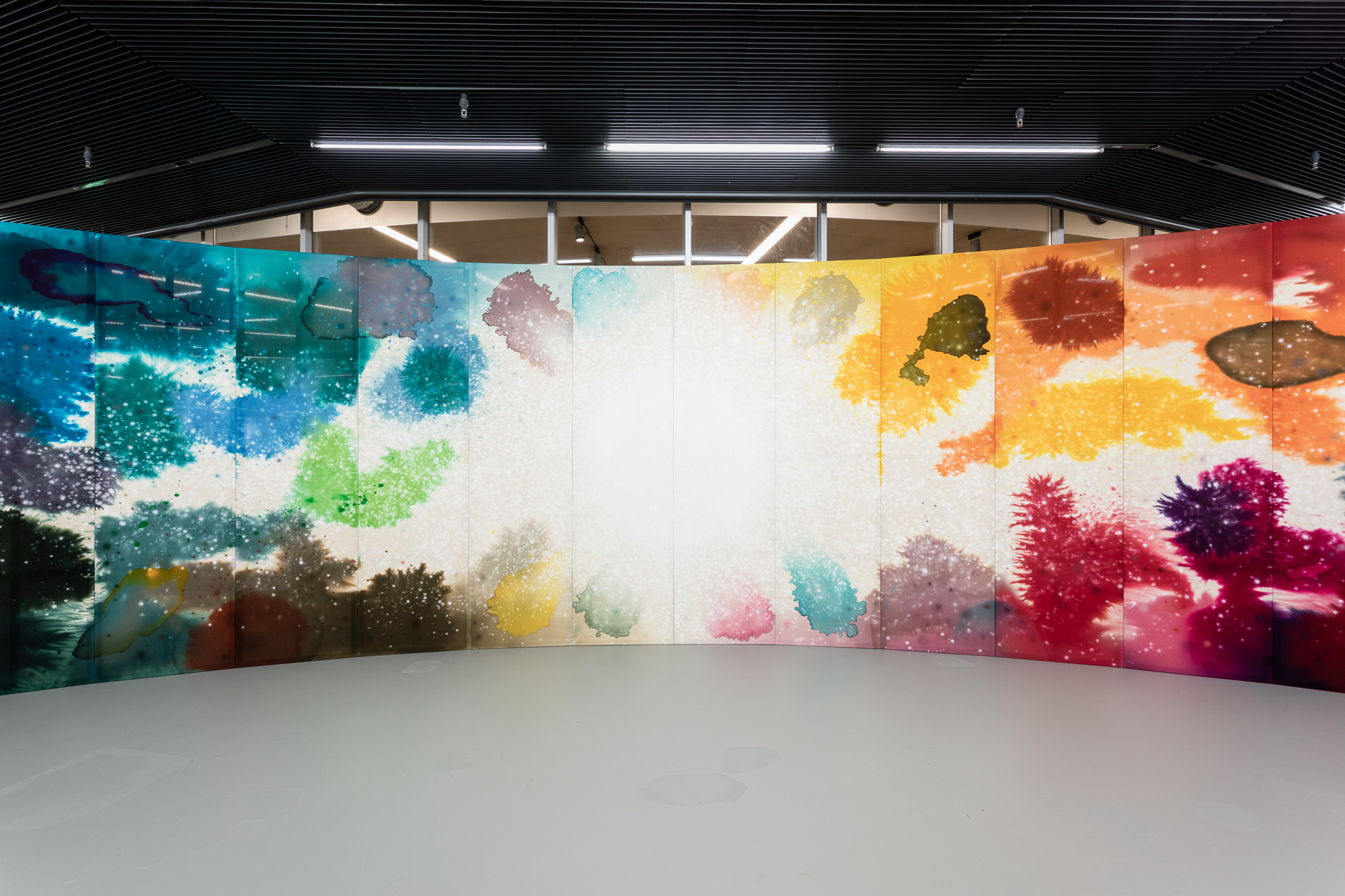
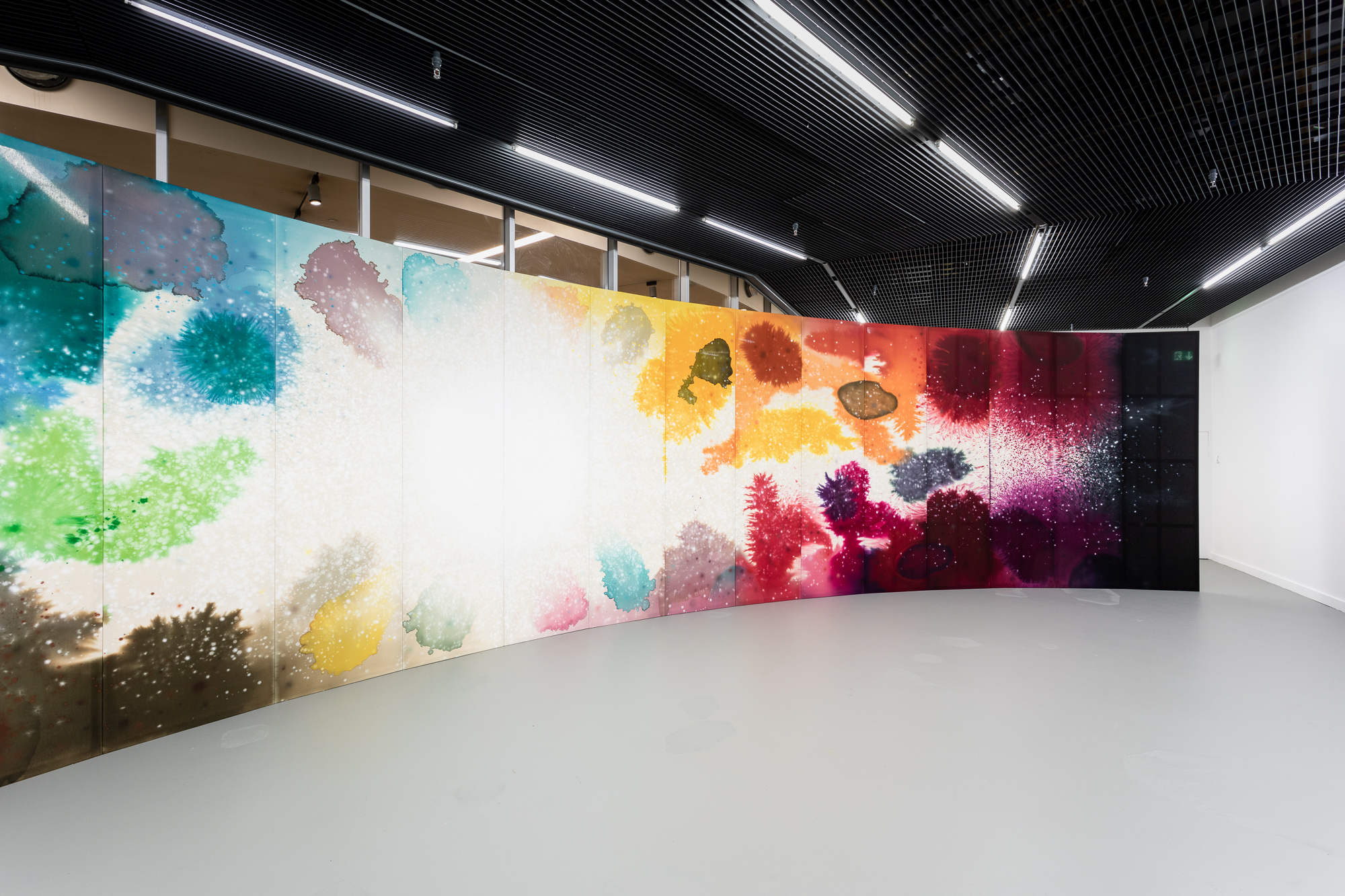
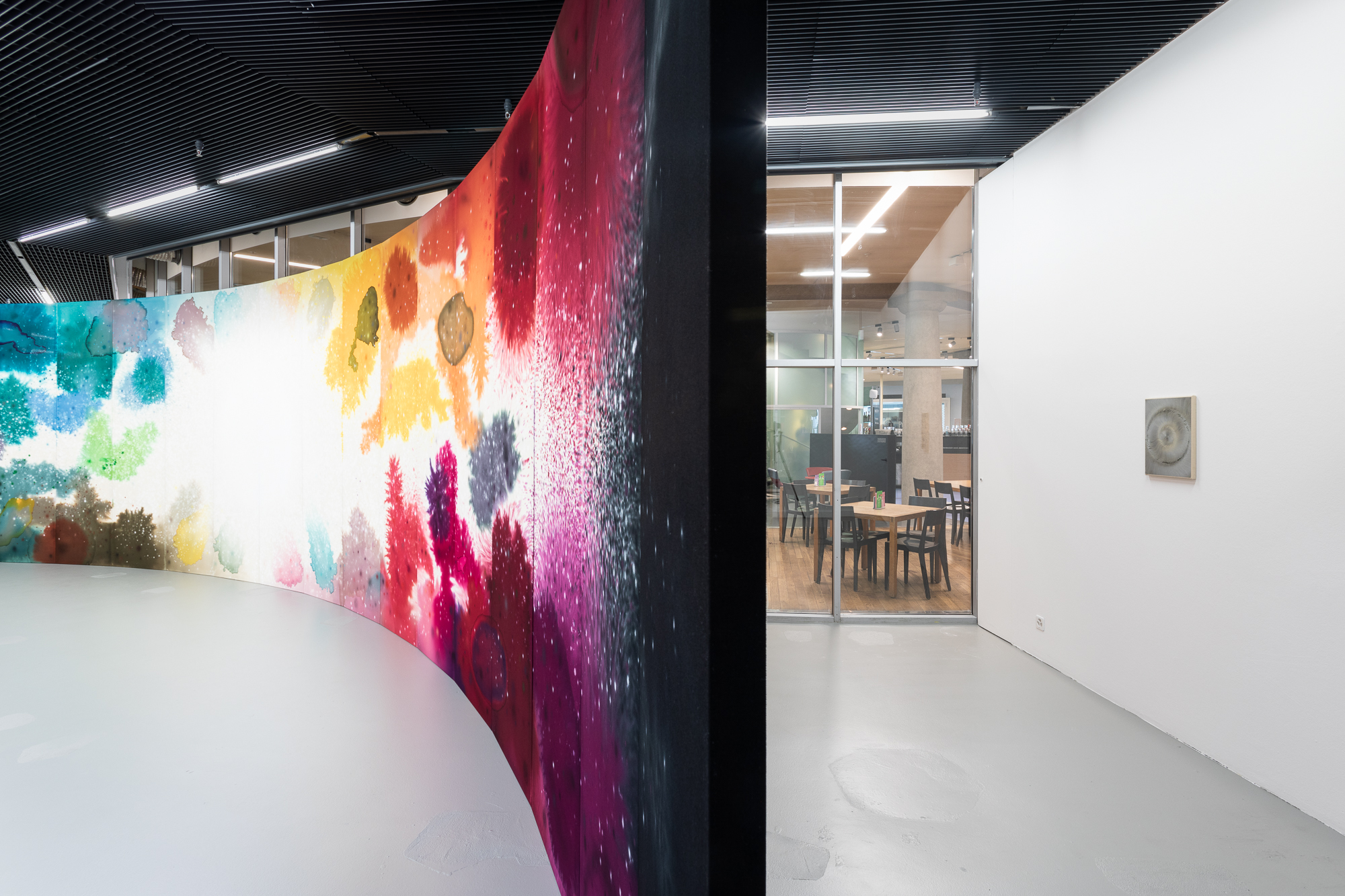
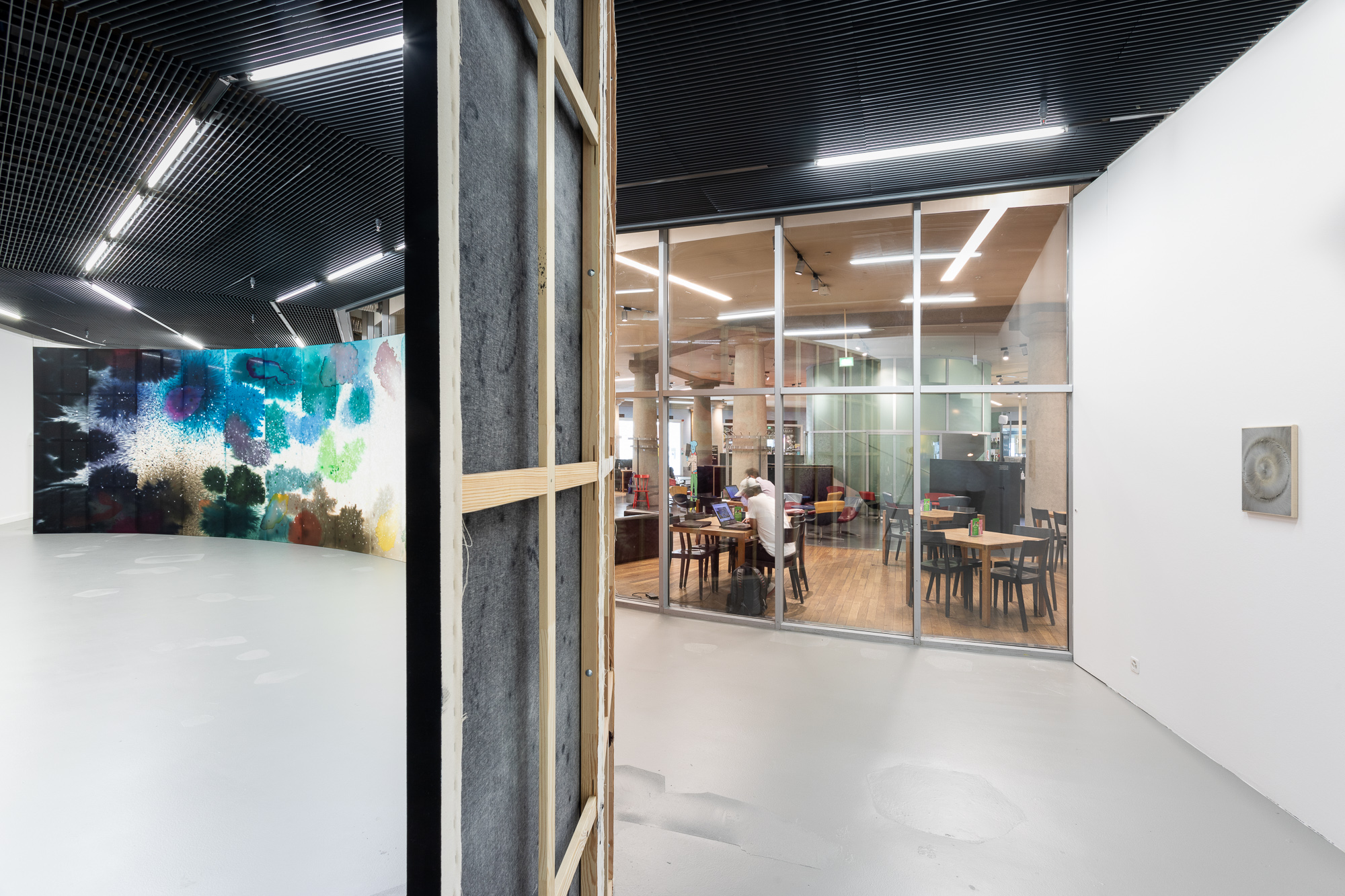
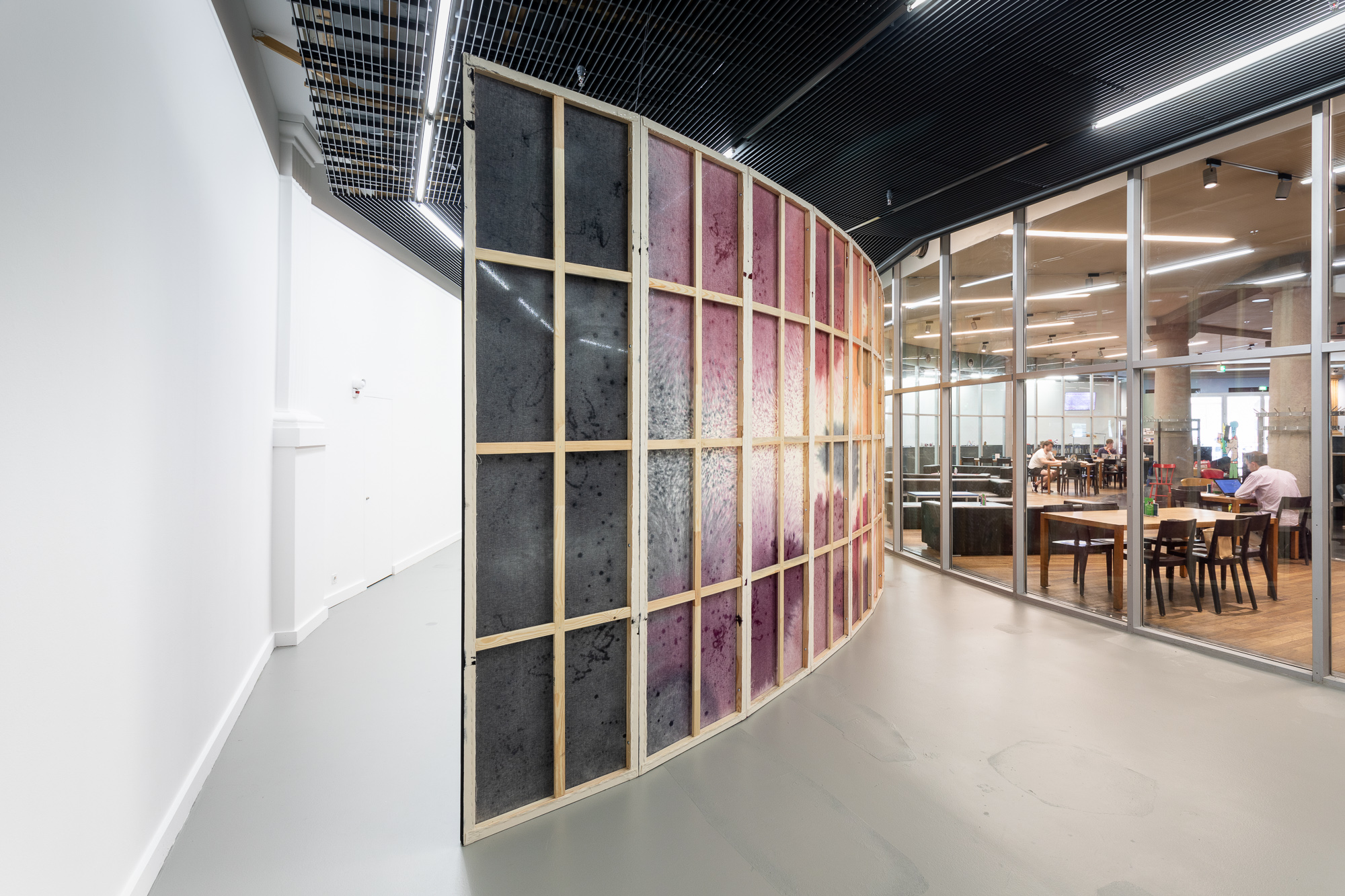

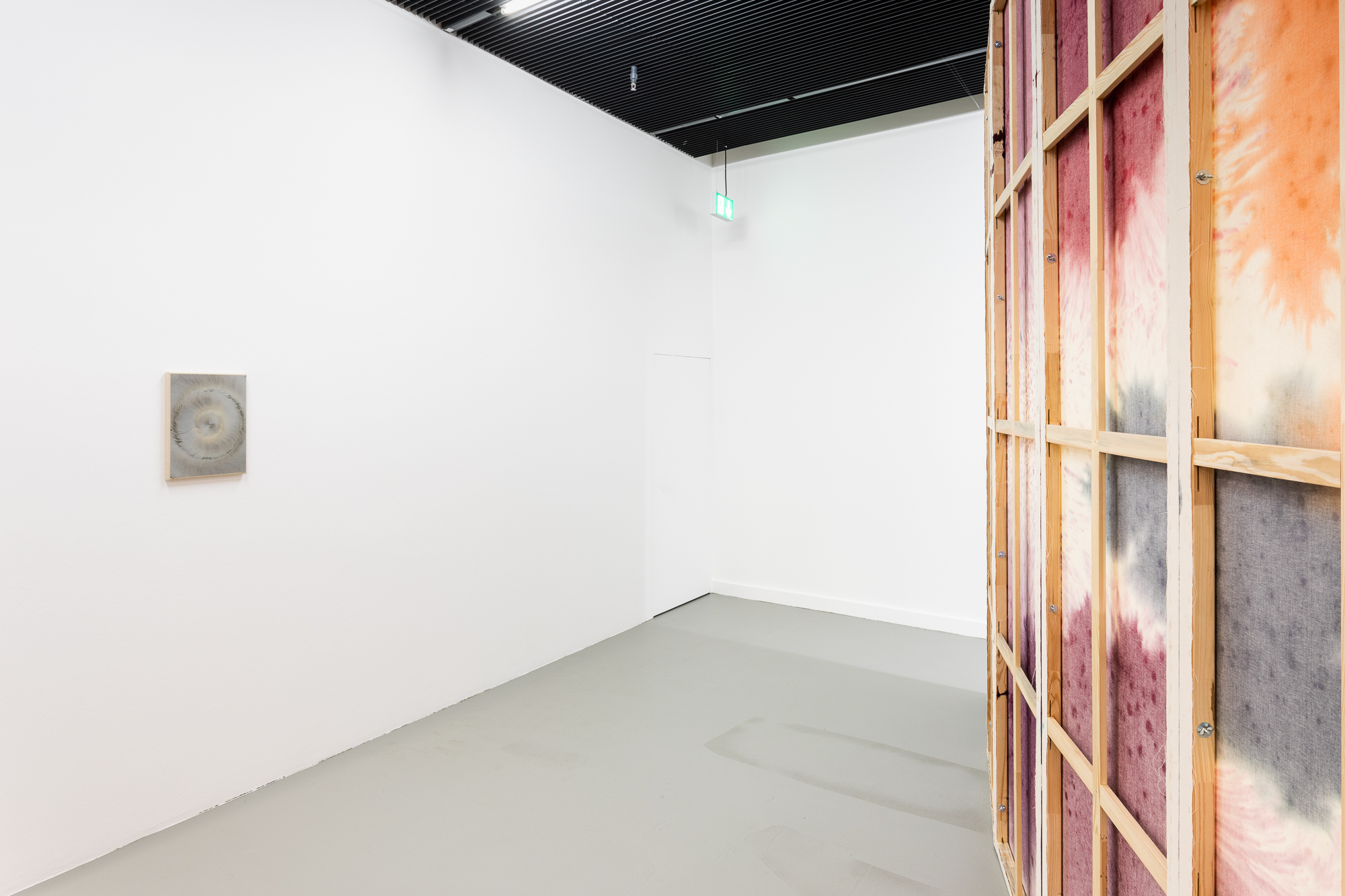
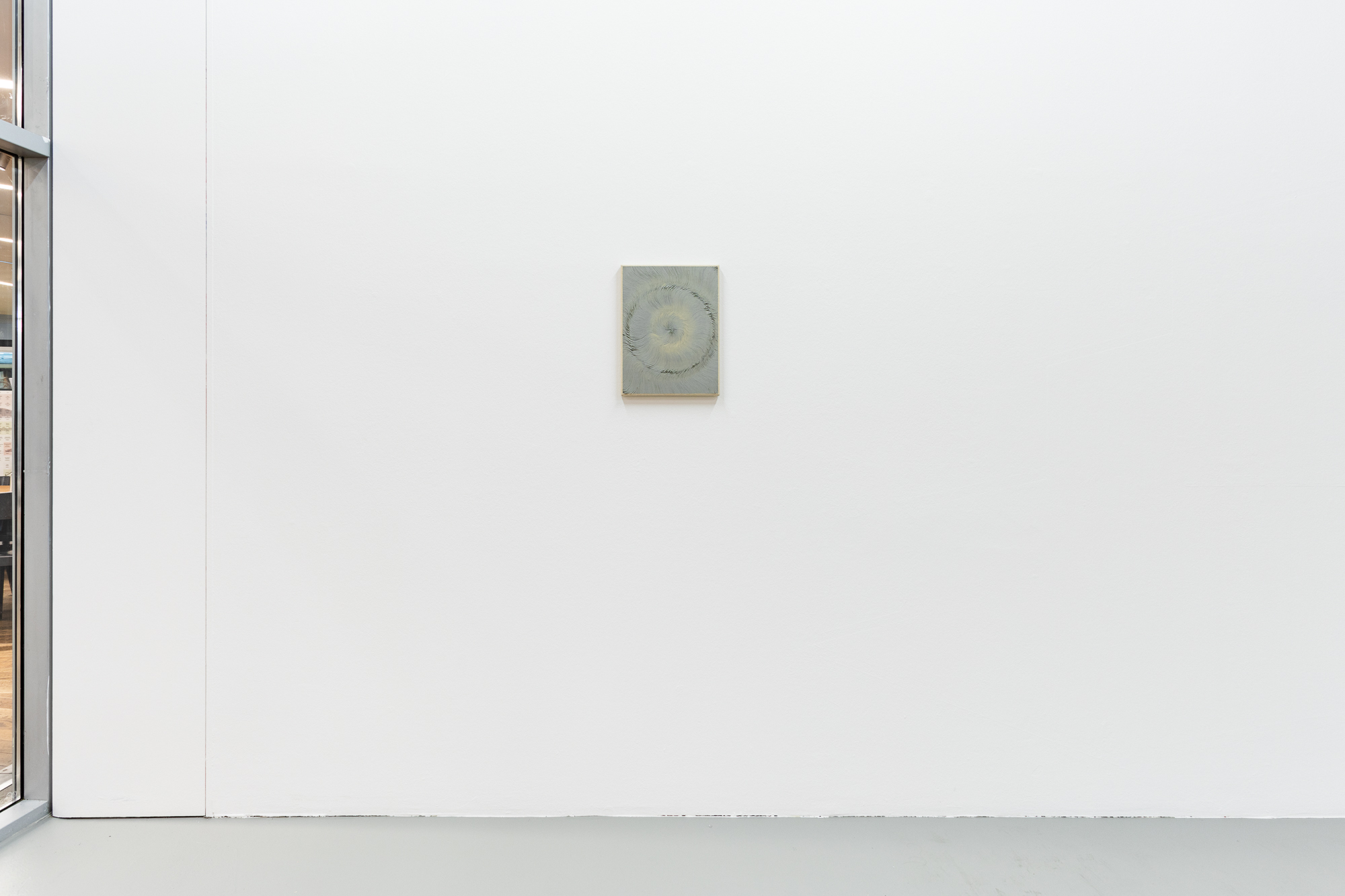
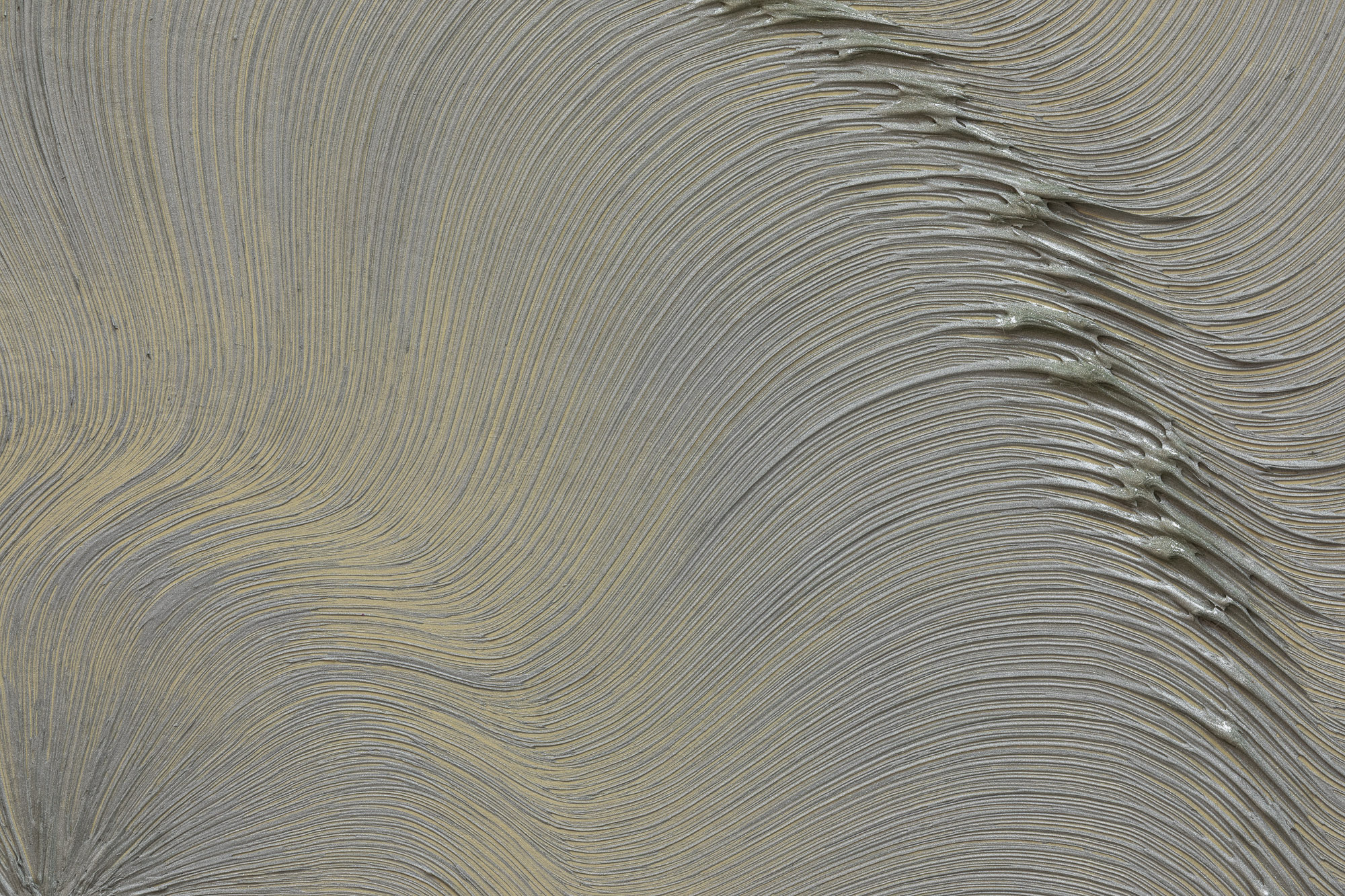
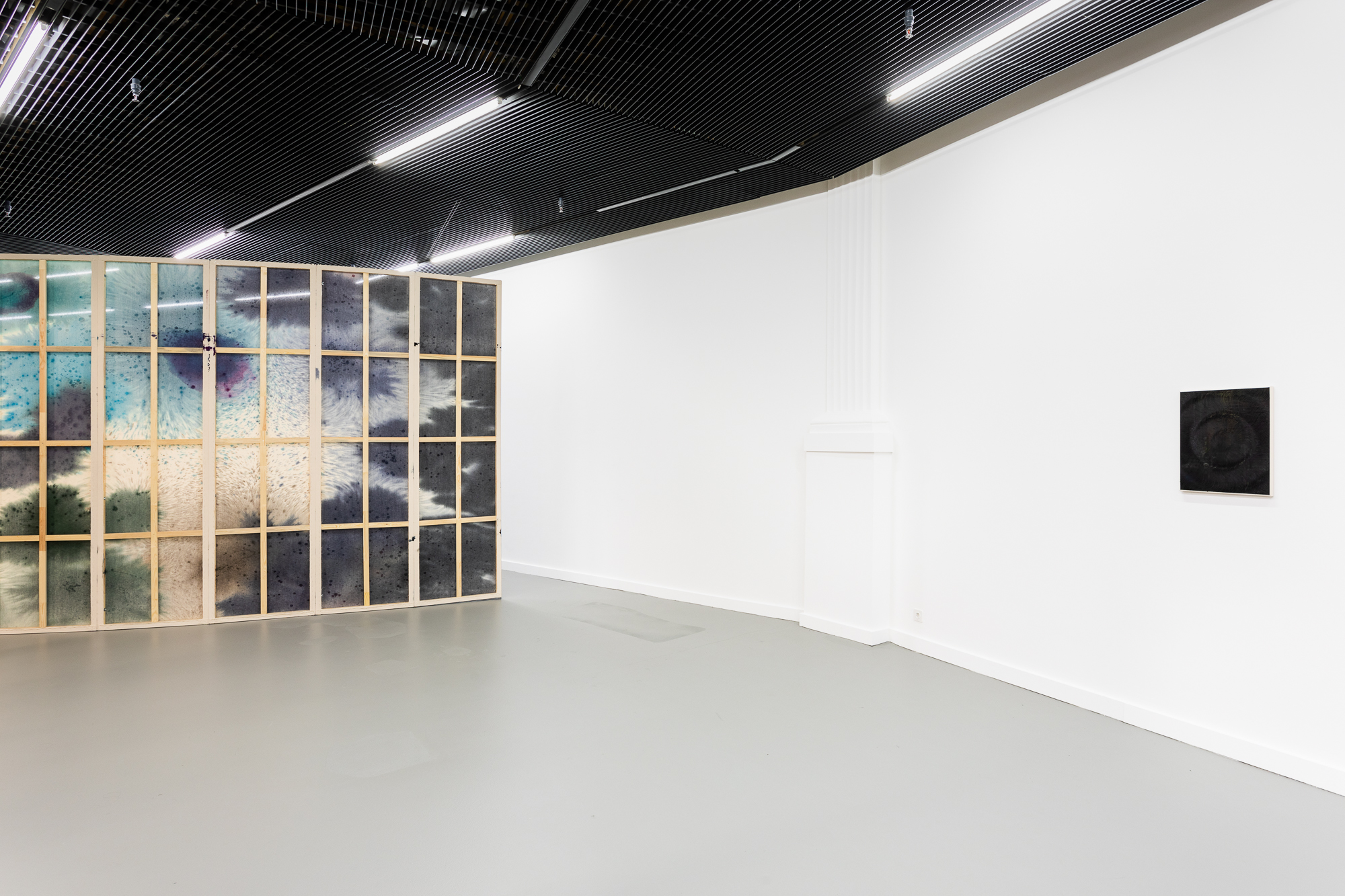
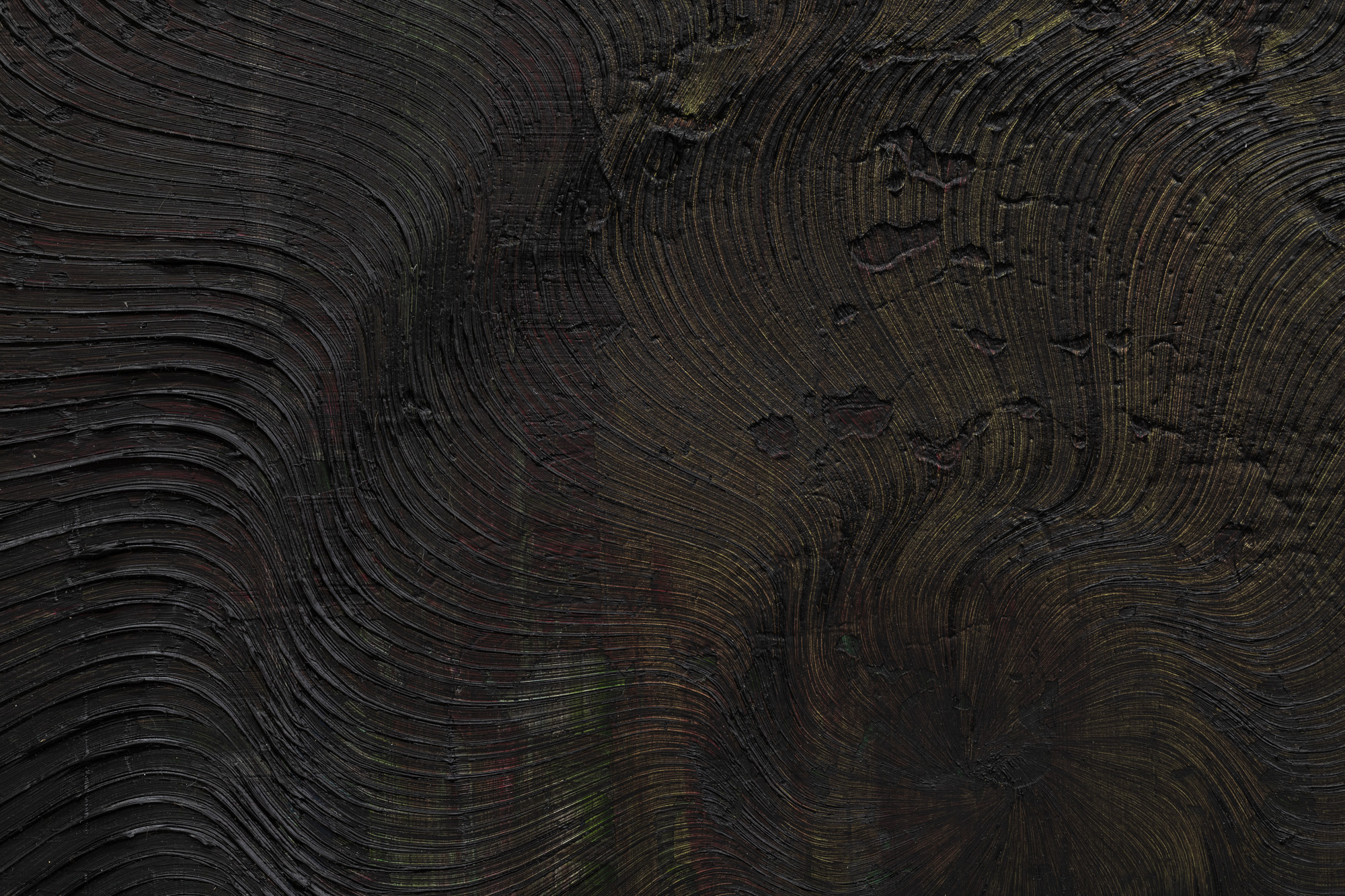
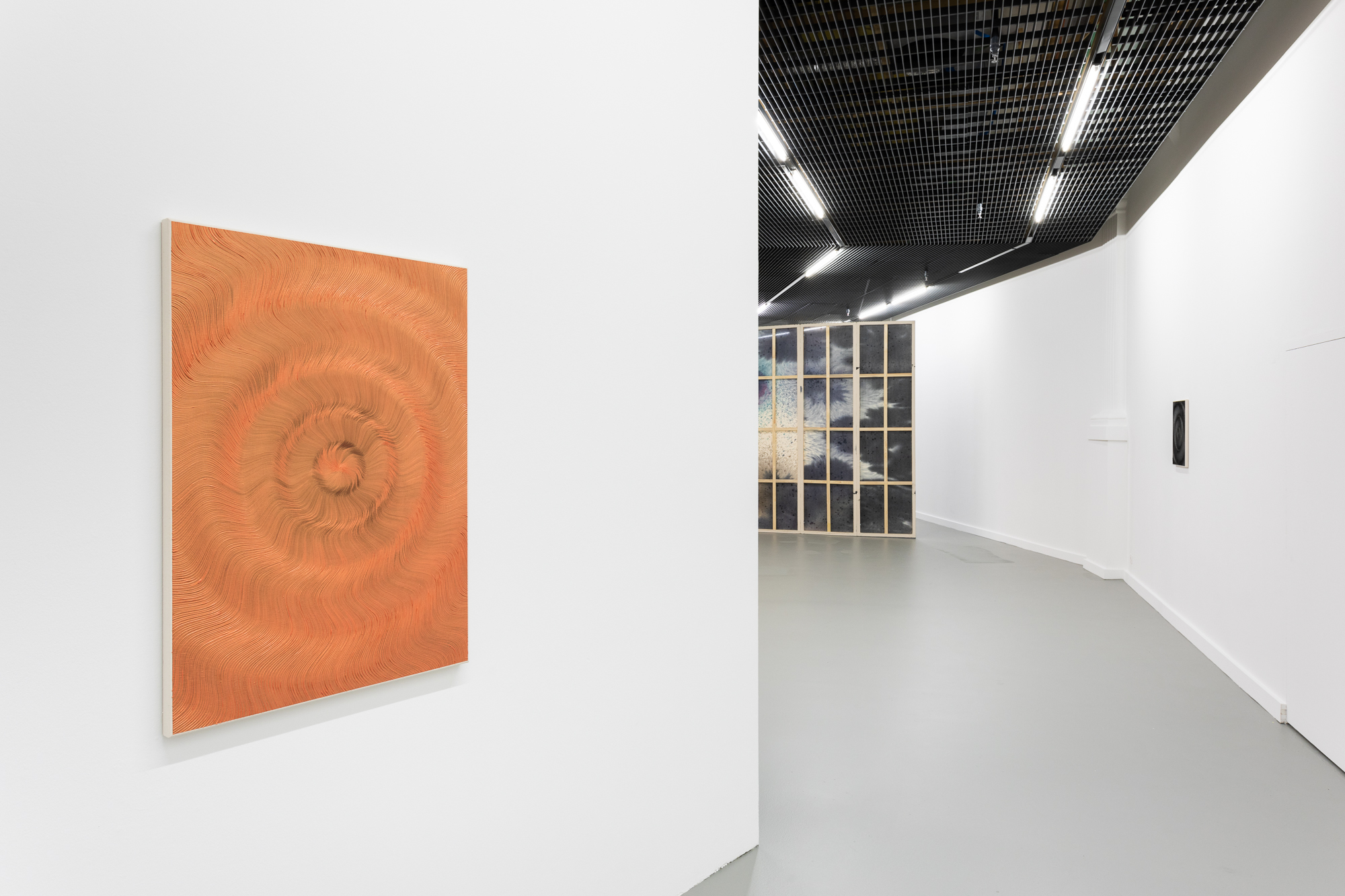
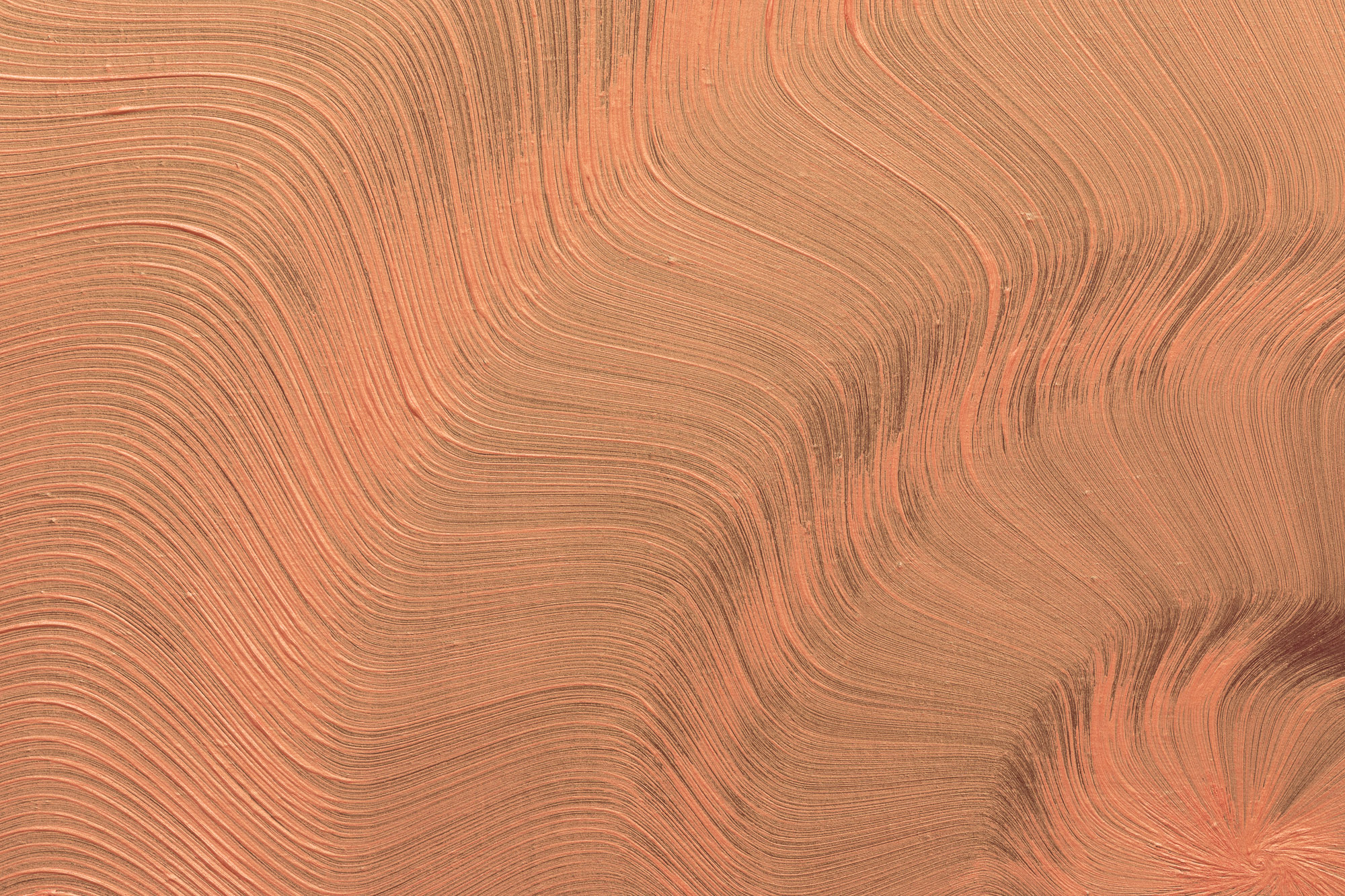
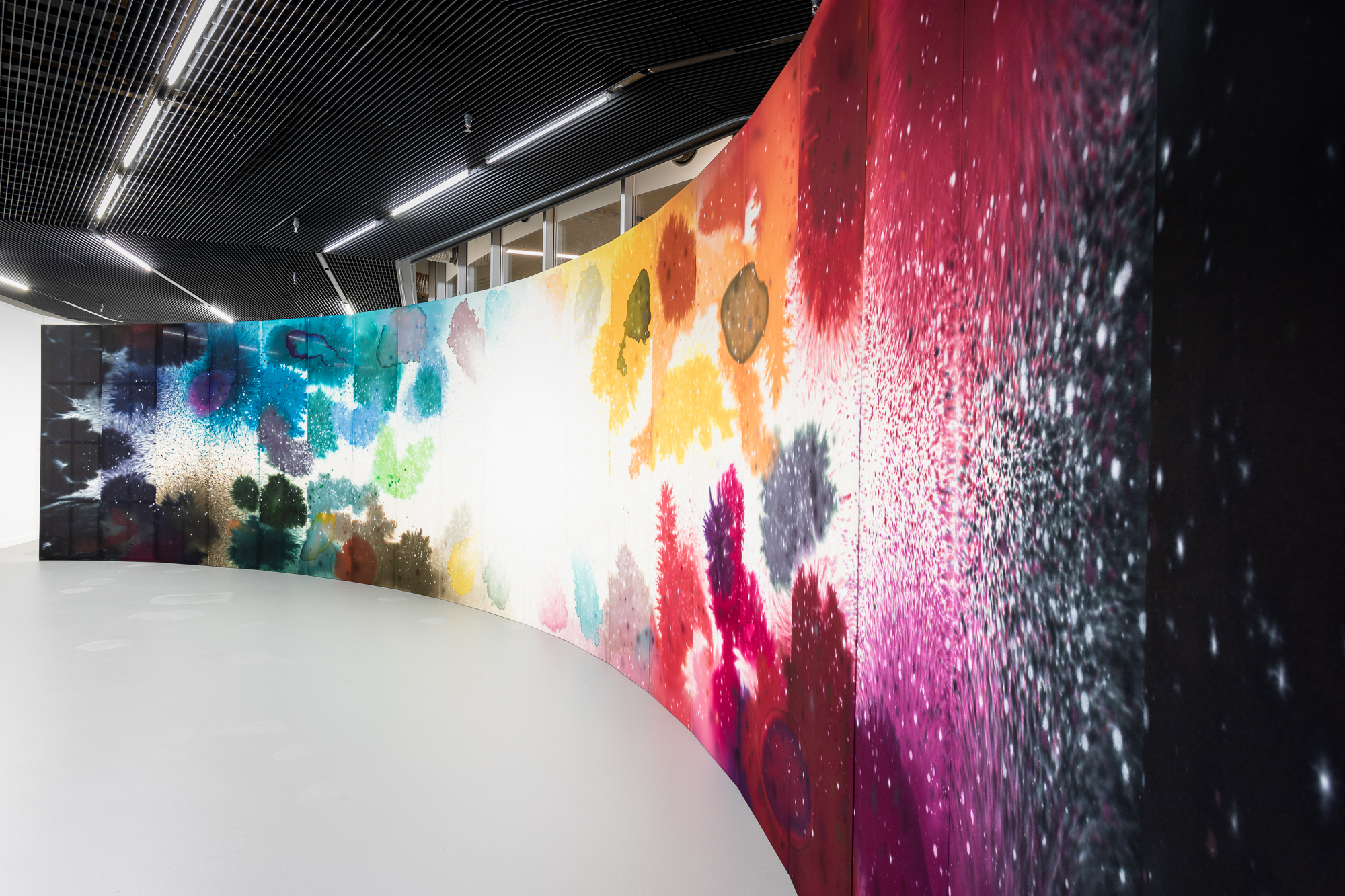

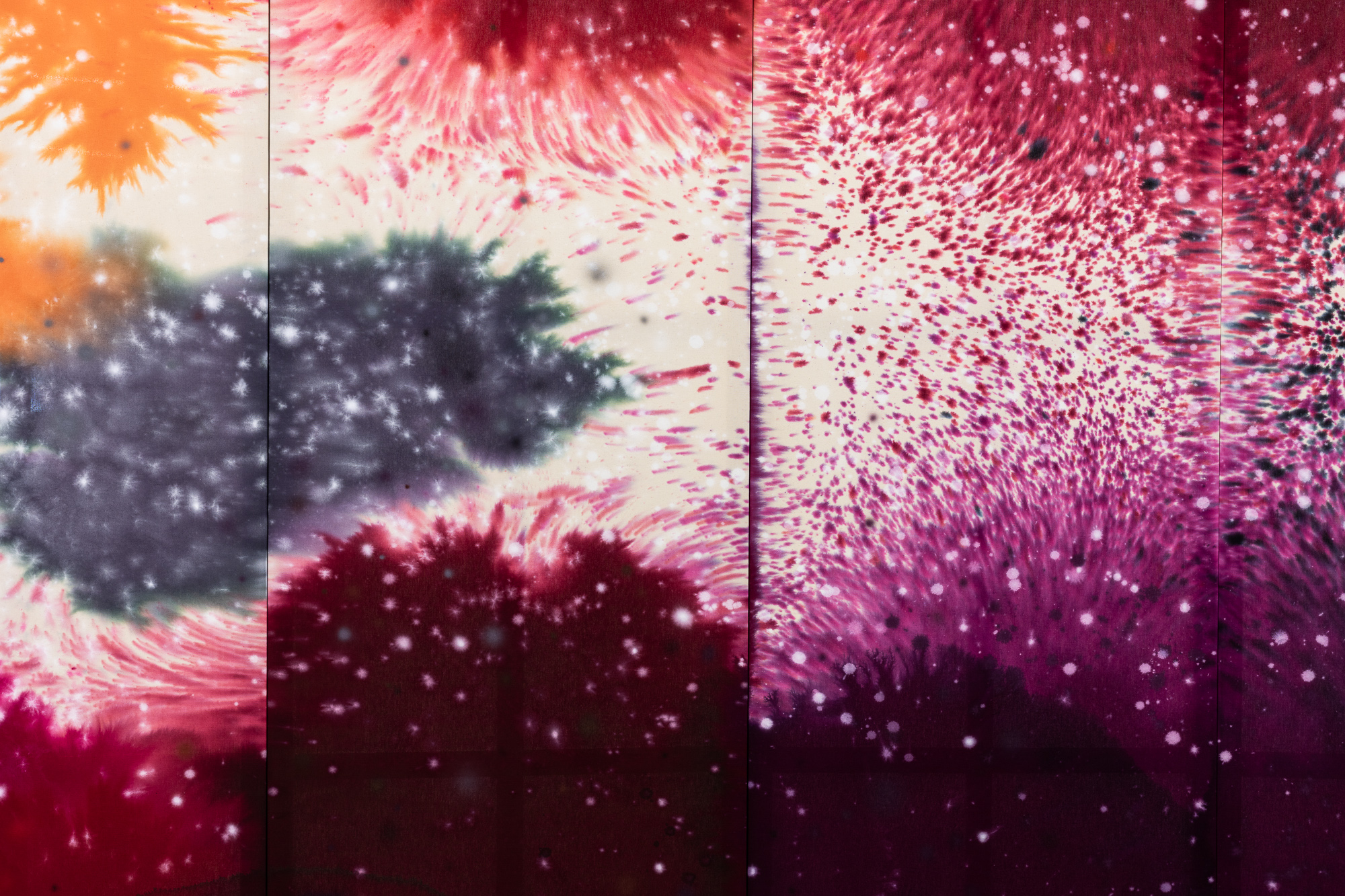
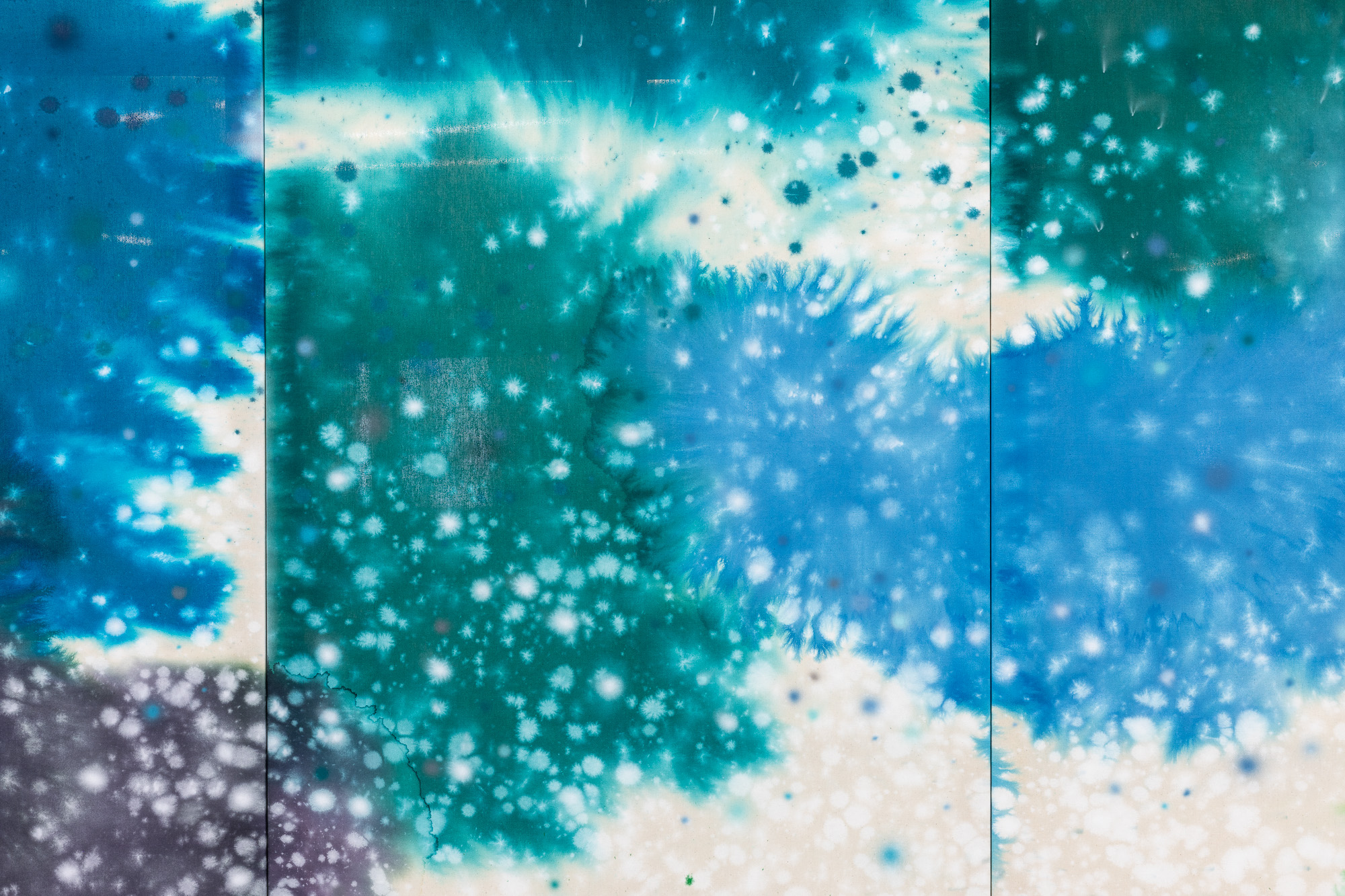
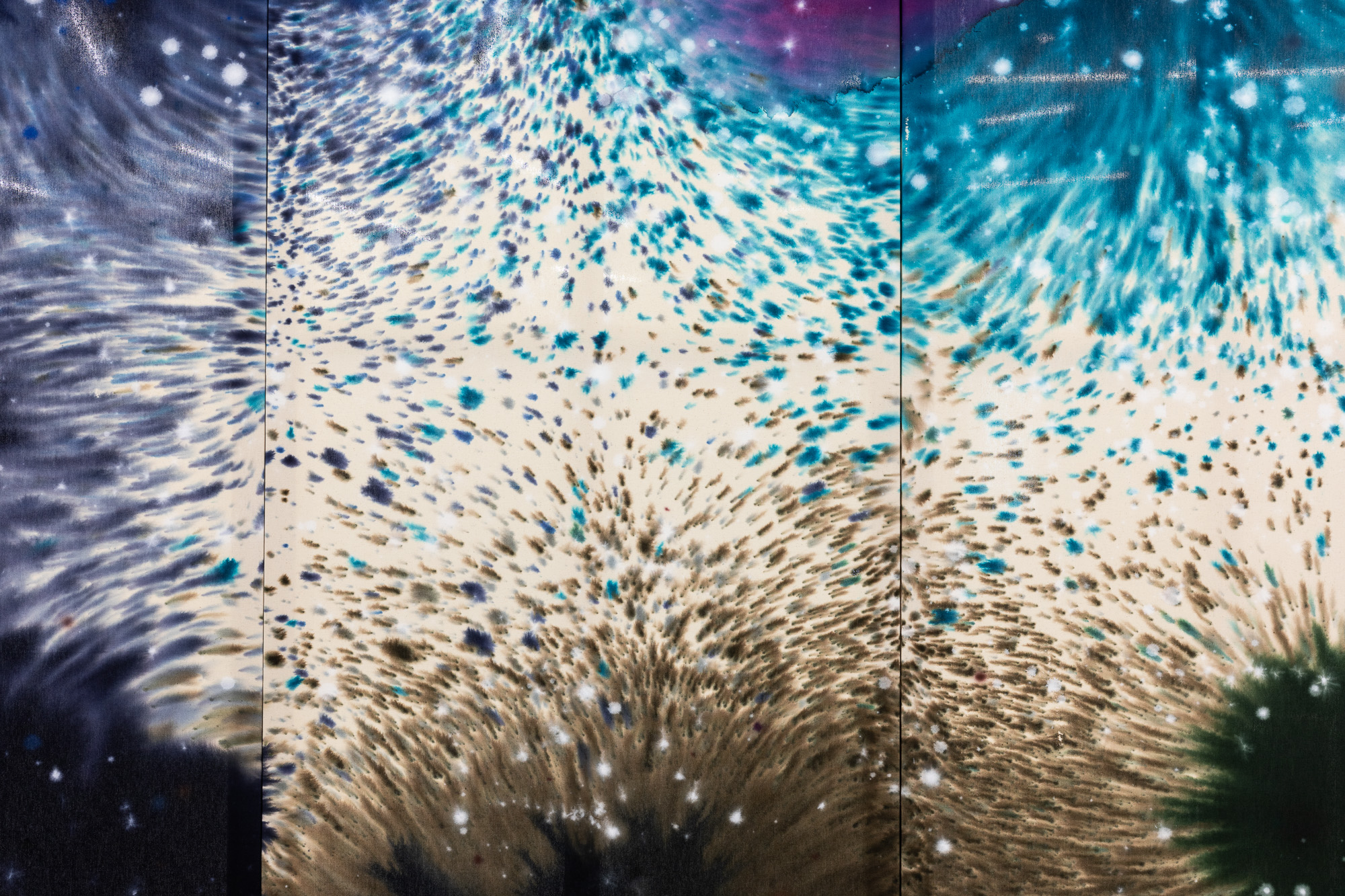
Mit einer Gegenbewegung zur vorherrschenden Architektur definiert die begehbare Installation ein komplett neues Raumgefühl, das sich je nach Blickwinkel stets zu verändern vermag. Giacomo Santiago Rogado (*1979 in Luzern) hat für die markanten Raumverhältnisse der Kunsthalle Luzern eine panoramaartige Malerei aus aneinandergereihten Leinwänden erstellt. Dabei steht die äussere Erscheinung in einer starken Wechselbeziehung zum Innern, das erst durch das Betreten des Ausstellungsraumes vollumfänglich ersichtlich wird.
In ihrer imposanten Dimension – 3m x 16m – zeigt die Installation eine farbintensive, abstrakte Malerei, die von Giacomo Santiago Rogado mit selbstentwickelten Techniken und experimentellen Malereiverfahren gefertigt wurde. Vom hellen Zentrum aus erstrecken sich symmetrisch nach links und rechts verschiedenste Farbverläufe, die sich überlagern und unterschiedliche Ebenen mit Tiefenwirkung erzeugen. Auf beide Seitenenden hin verdunkelt sich die Farbigkeit und endet in nachtschwarzen Bildbereichen. Wie ein orchestrierter Zufall wirken die wachsenden Farbeffekte, die aufgrund der Transparenz der Leinwände zwischen Sein und Schein changieren.
Die malerischen Arbeiten von Giacomo Santiago Rogado erschliessen sich nicht per se auf den ersten Blick, vielmehr bedarf es eine visuelle und kontemplative Auseinandersetzung, damit die Werke ihre expressive Wirkung entfalten können. Betrachtenden.
In ihrer imposanten Dimension – 3m x 16m – zeigt die Installation eine farbintensive, abstrakte Malerei, die von Giacomo Santiago Rogado mit selbstentwickelten Techniken und experimentellen Malereiverfahren gefertigt wurde. Vom hellen Zentrum aus erstrecken sich symmetrisch nach links und rechts verschiedenste Farbverläufe, die sich überlagern und unterschiedliche Ebenen mit Tiefenwirkung erzeugen. Auf beide Seitenenden hin verdunkelt sich die Farbigkeit und endet in nachtschwarzen Bildbereichen. Wie ein orchestrierter Zufall wirken die wachsenden Farbeffekte, die aufgrund der Transparenz der Leinwände zwischen Sein und Schein changieren.
Die malerischen Arbeiten von Giacomo Santiago Rogado erschliessen sich nicht per se auf den ersten Blick, vielmehr bedarf es eine visuelle und kontemplative Auseinandersetzung, damit die Werke ihre expressive Wirkung entfalten können. Betrachtenden.
Generell regen seine Arbeiten den individuellen Sehprozess an und beeinflussen die räumliche Wahrnehmung der Optische Illusionen erwirkt Giacomo Santiago Rogado mit den drei kleinformatigen Malereien aus der Serie «Coalescence», die sich als minimale Setzungen im Hauptraum gegenüber der monumentalen Installation behaupten. Von der Ferne wirken die drei Arbeiten mehr oder weniger einfarbig, wobei sich die geschwungenen Linien mit ihrem Zentrum erst bei näherem Betrachten erschliessen. Ein kontrollierter, meditativer Malereiprozess mit Acryl und Öl ergibt eine dynamisch-wellige Struktur in Kreisformat, deren Farbigkeit sich beim Vorbeigehen stetig verändert.
Im Kabinett der Kunsthalle Luzern zeigt Giacomo Santiago Rogado eine Auswahl gerahmter, kleinformatiger Papierarbeiten. In einer dichten, gleichmässigen Aneinanderreihung werden verschiedene Varianten seines Umgangs mit Farben, Formen und Strukturen sichtbar. Die Papierarbeiten fungieren wie ein Mind-Map, welches die Spannbreite seines technischen Schaffens aufzeigt und die Weiterentwicklung von Forschung und Formfindung dokumentiert. Es handelt sich um eigenständige Arbeiten, worin sich seine selbst entwickelten Techniken vermischen und neuartige Malerei-Kombinationen generieren.
Michael Sutter
Im Kabinett der Kunsthalle Luzern zeigt Giacomo Santiago Rogado eine Auswahl gerahmter, kleinformatiger Papierarbeiten. In einer dichten, gleichmässigen Aneinanderreihung werden verschiedene Varianten seines Umgangs mit Farben, Formen und Strukturen sichtbar. Die Papierarbeiten fungieren wie ein Mind-Map, welches die Spannbreite seines technischen Schaffens aufzeigt und die Weiterentwicklung von Forschung und Formfindung dokumentiert. Es handelt sich um eigenständige Arbeiten, worin sich seine selbst entwickelten Techniken vermischen und neuartige Malerei-Kombinationen generieren.
Michael Sutter
2021
Kopf Herz Bauch
Solo show
Galerie Mark Müller
Galerie Mark Müller
4/24 – 6/5/21
Zürich
Zürich
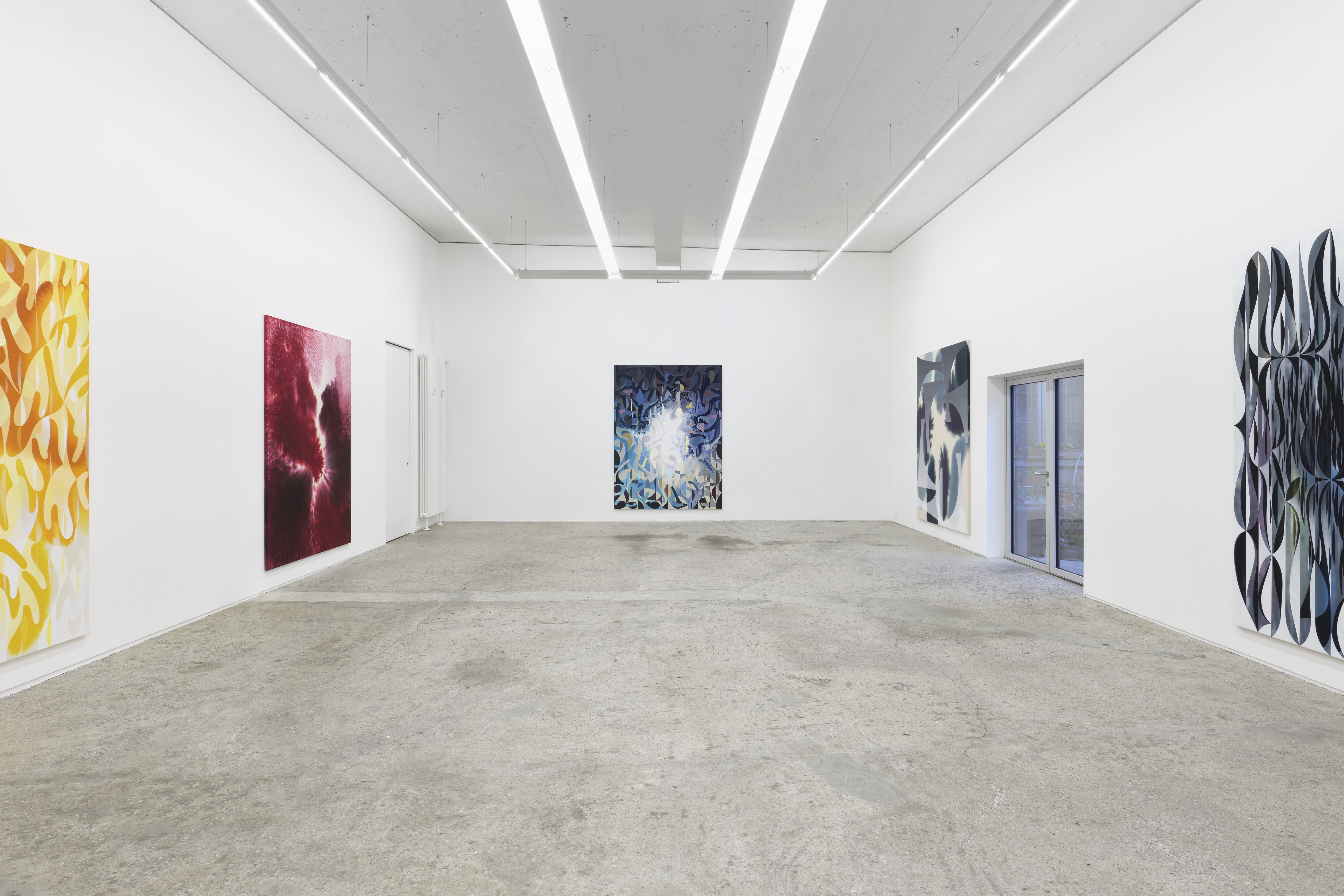
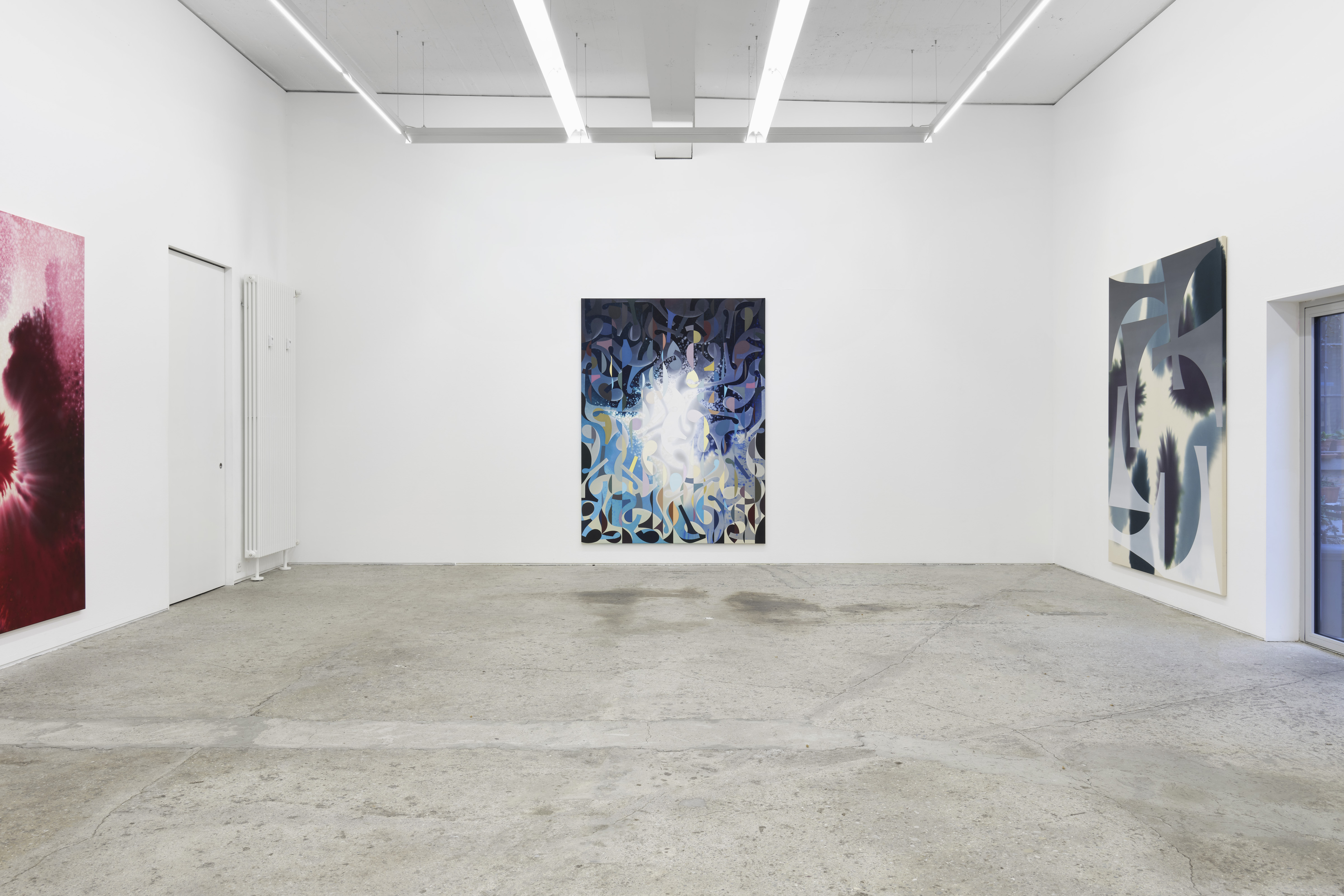
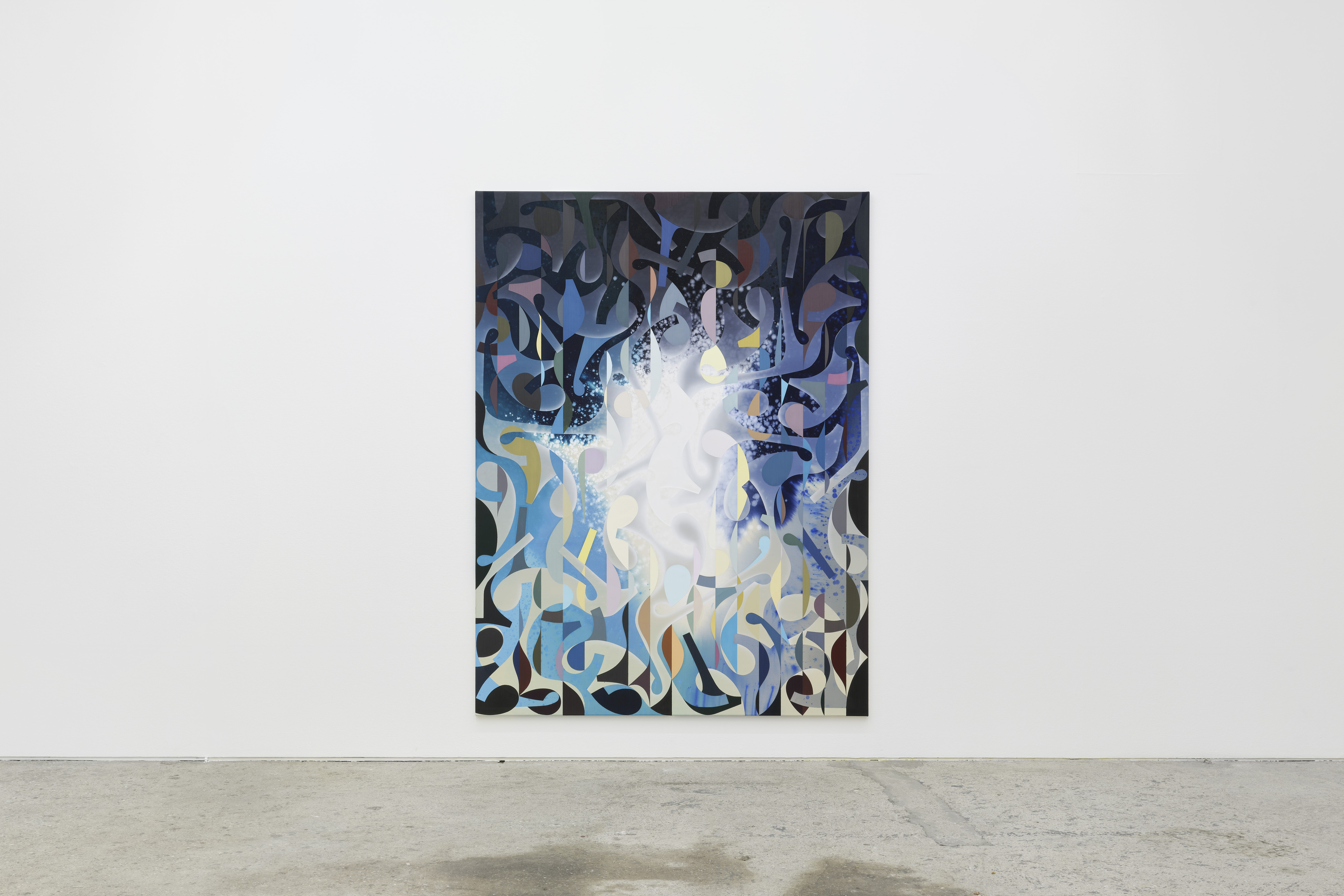
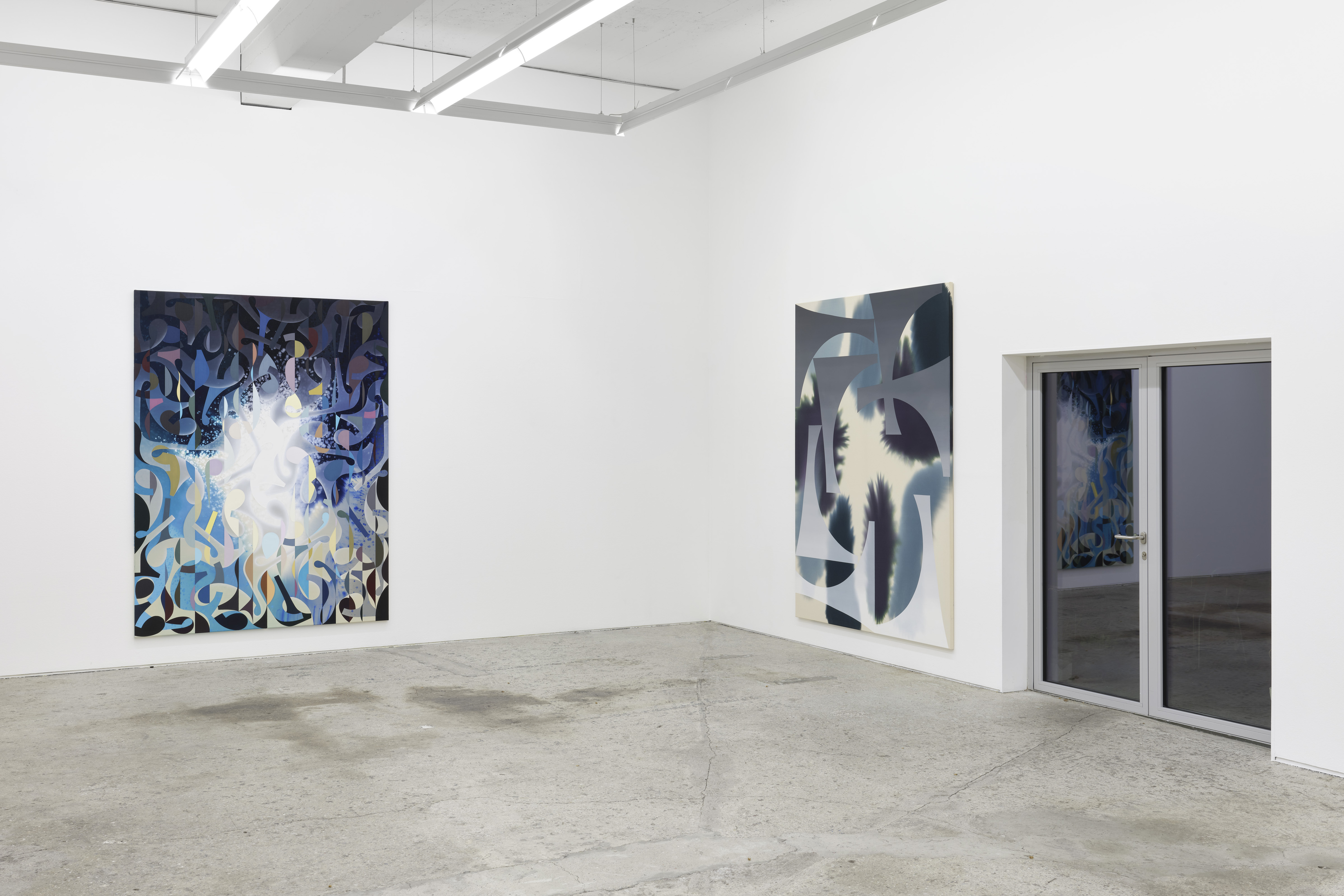
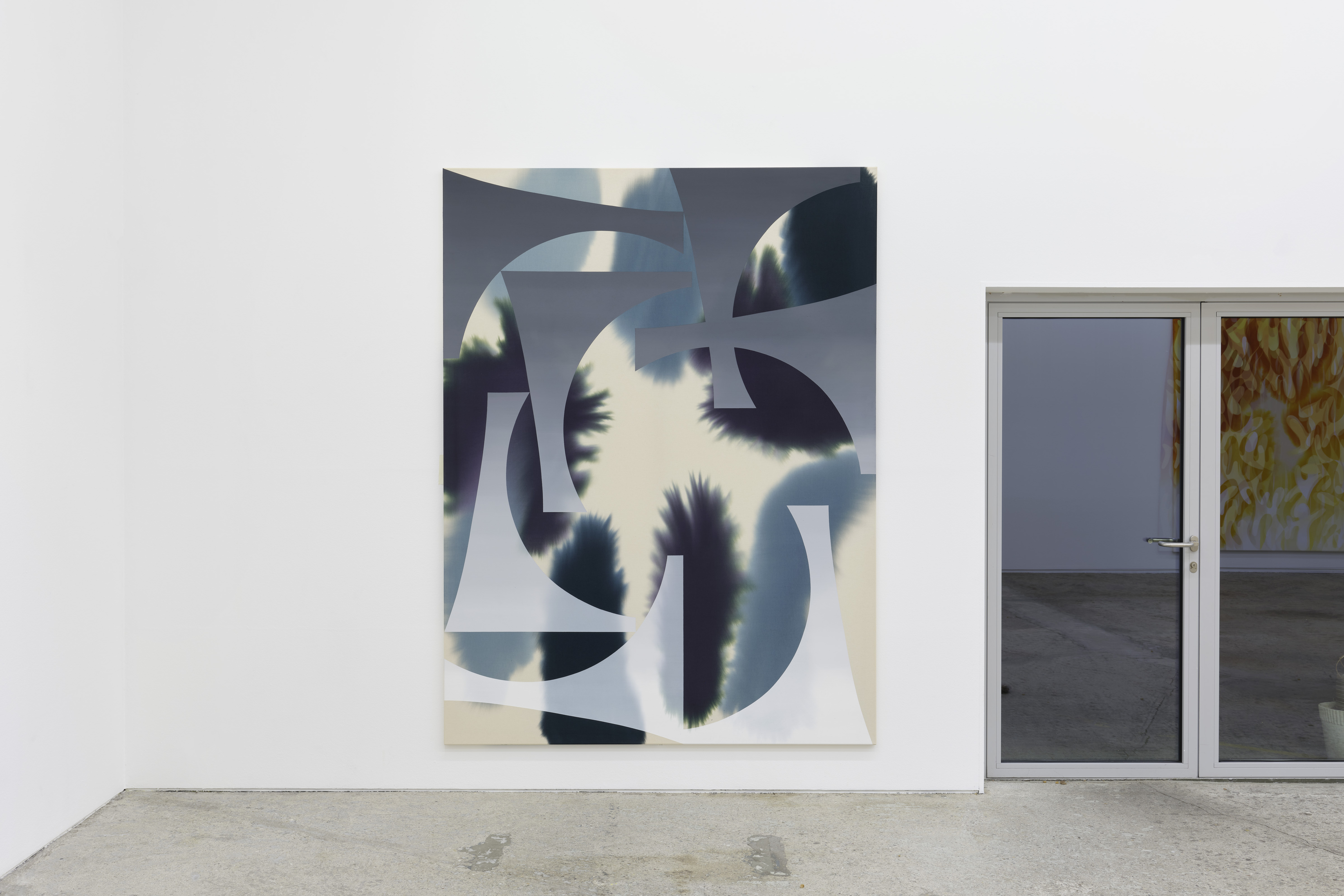
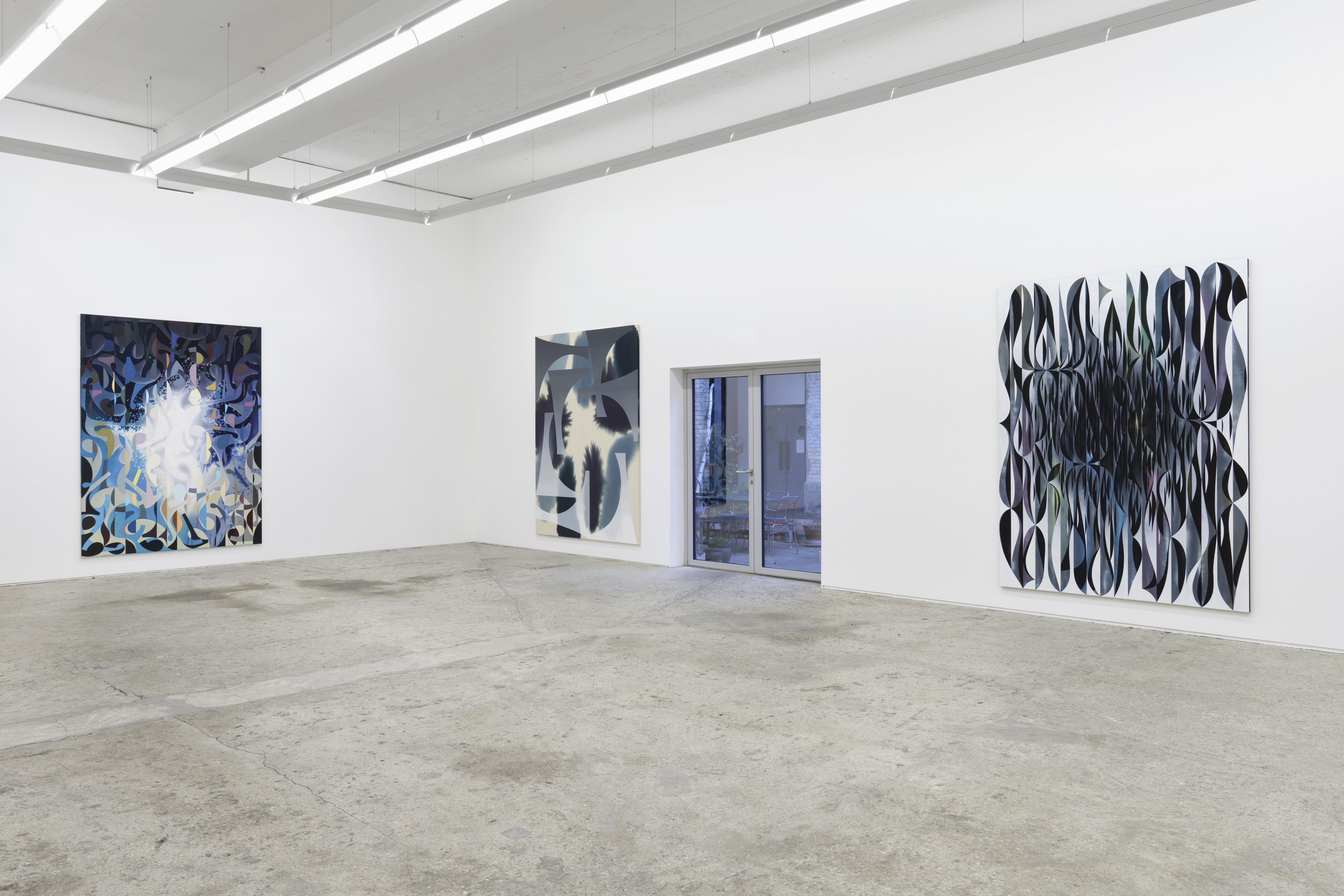
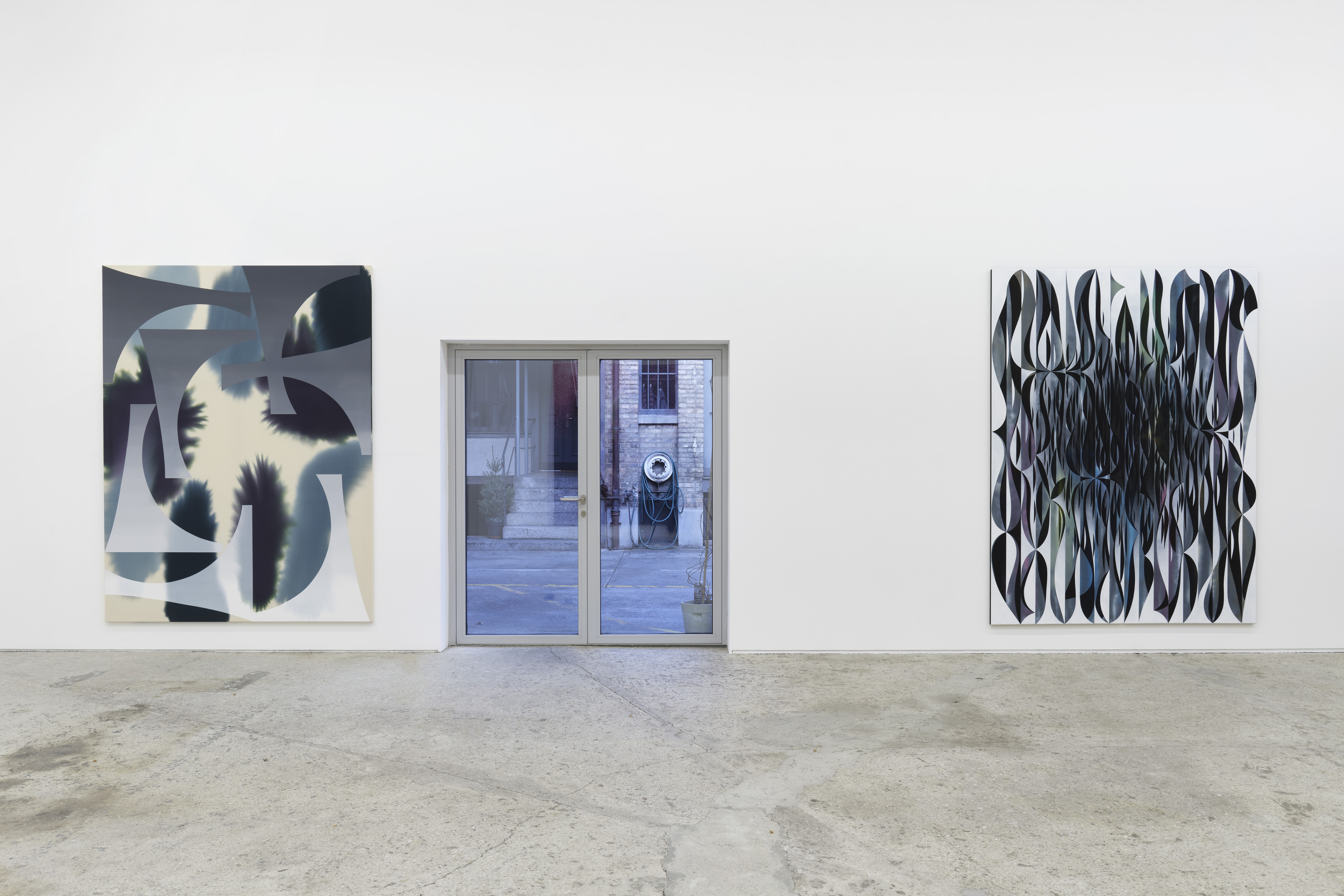
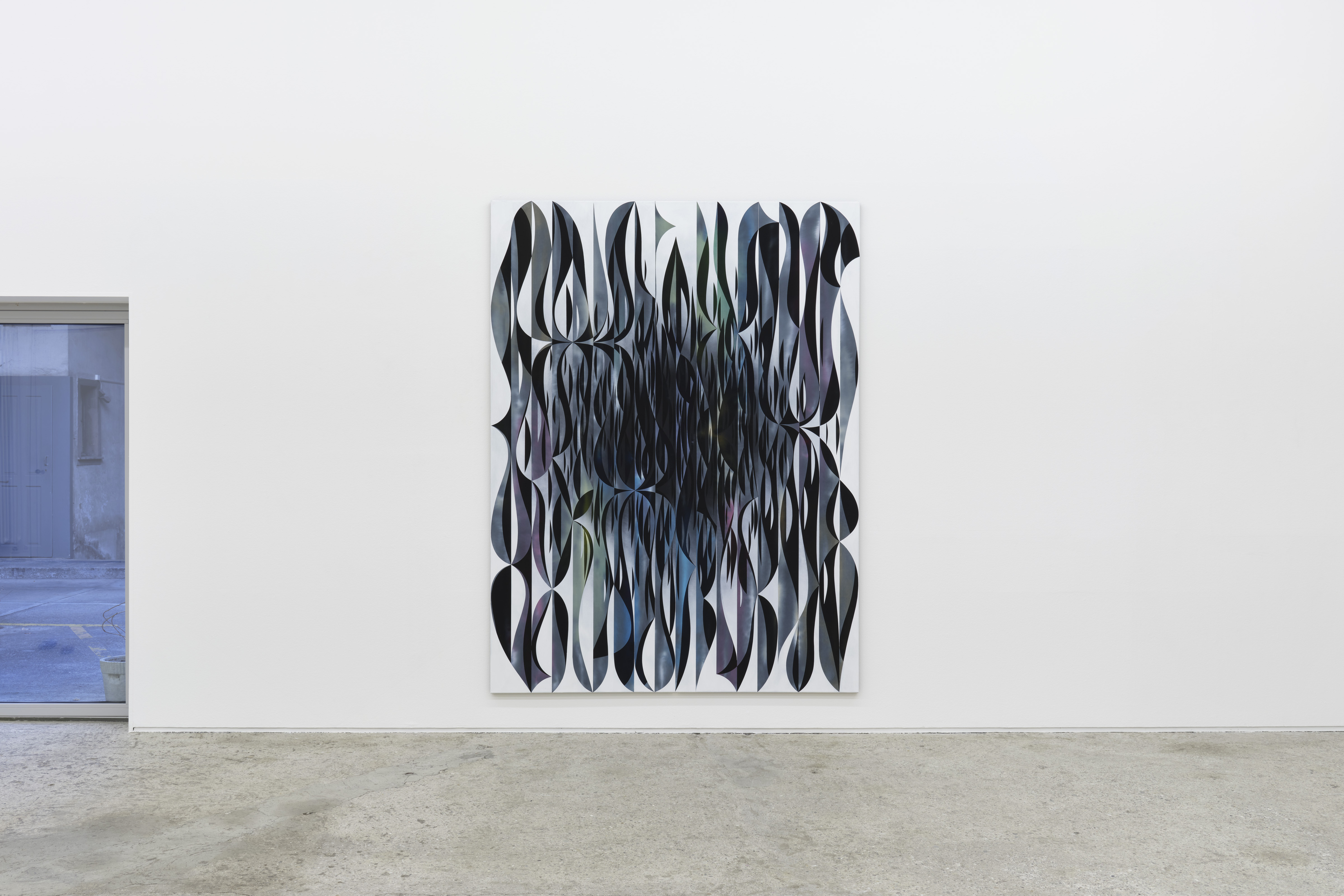
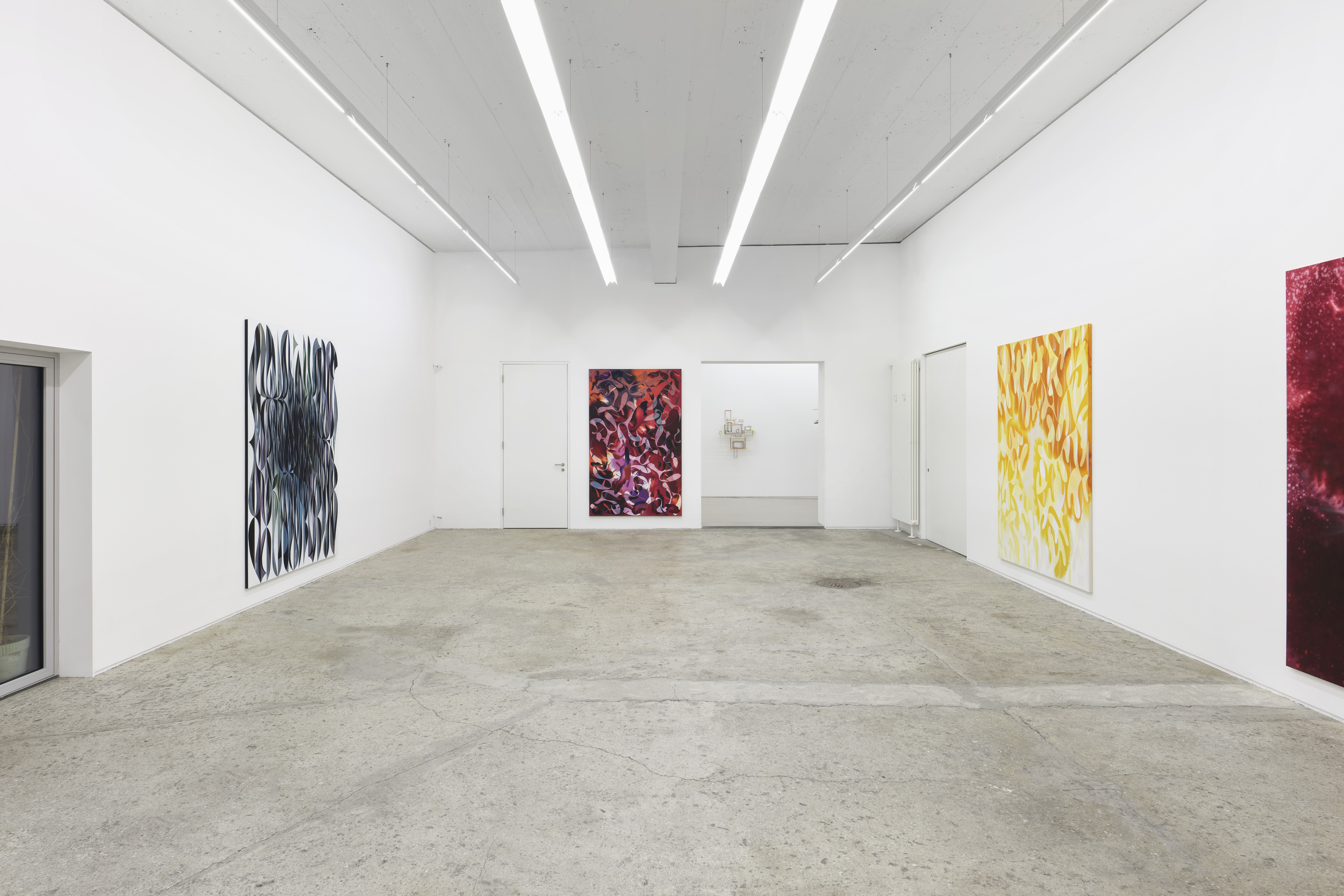
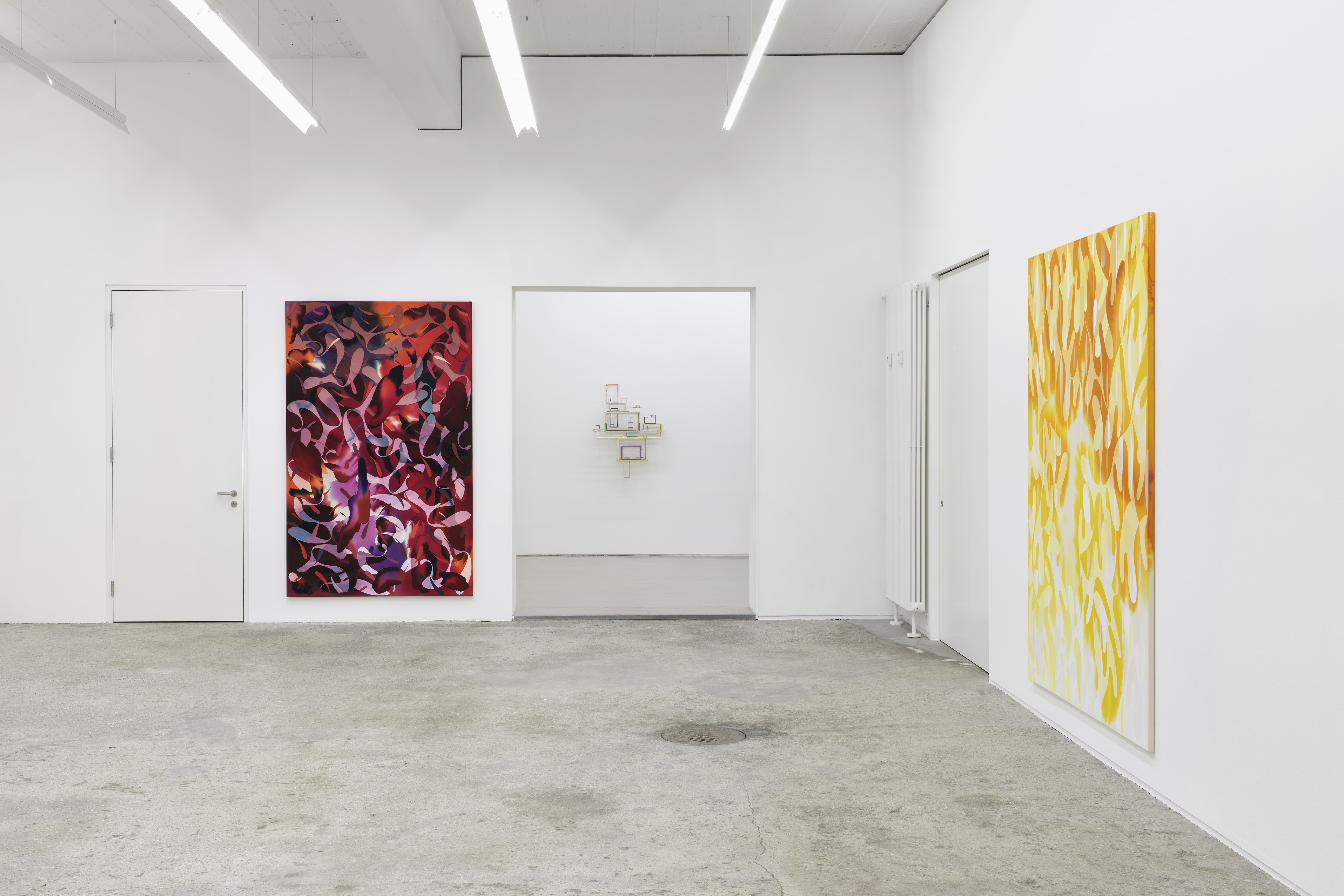
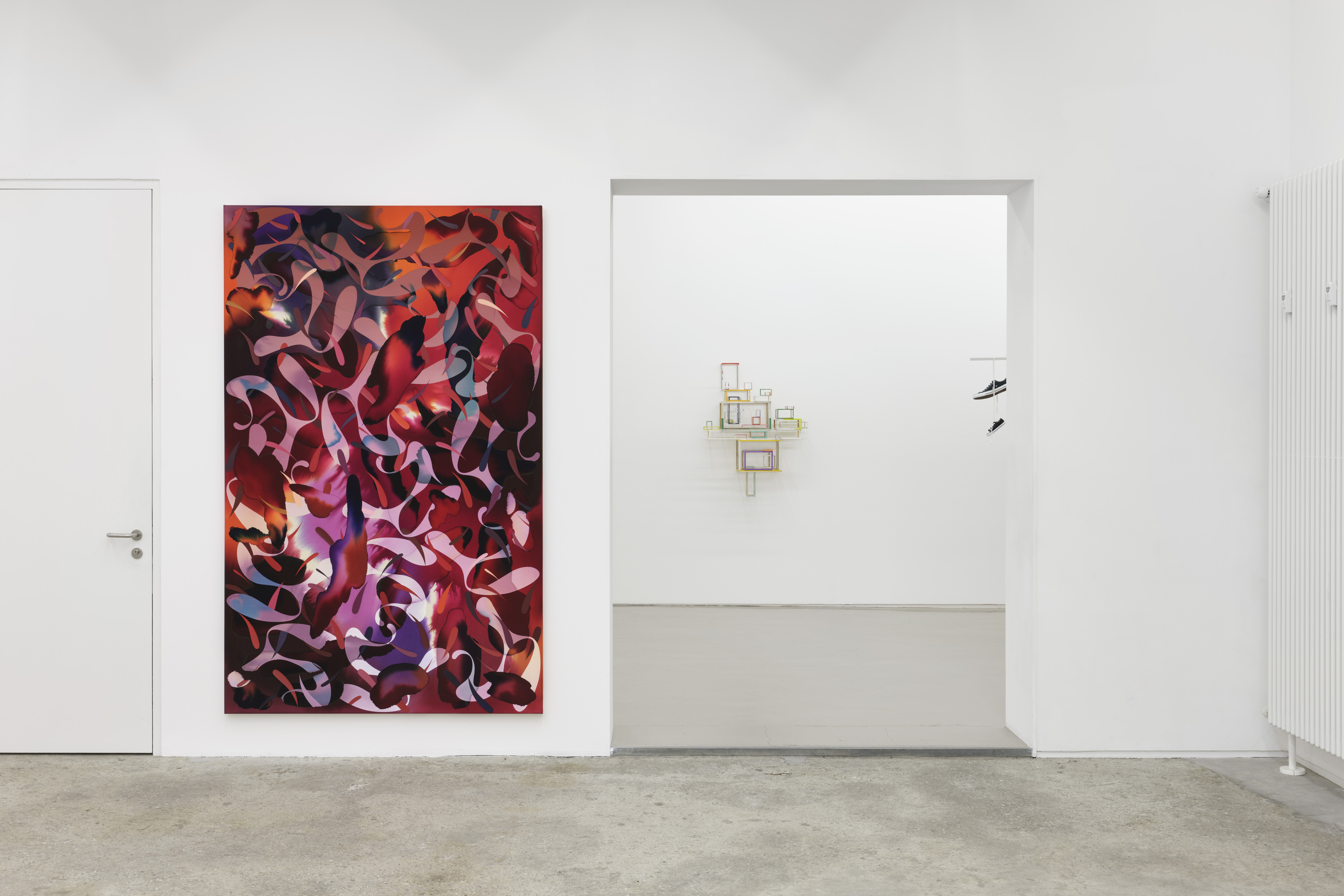
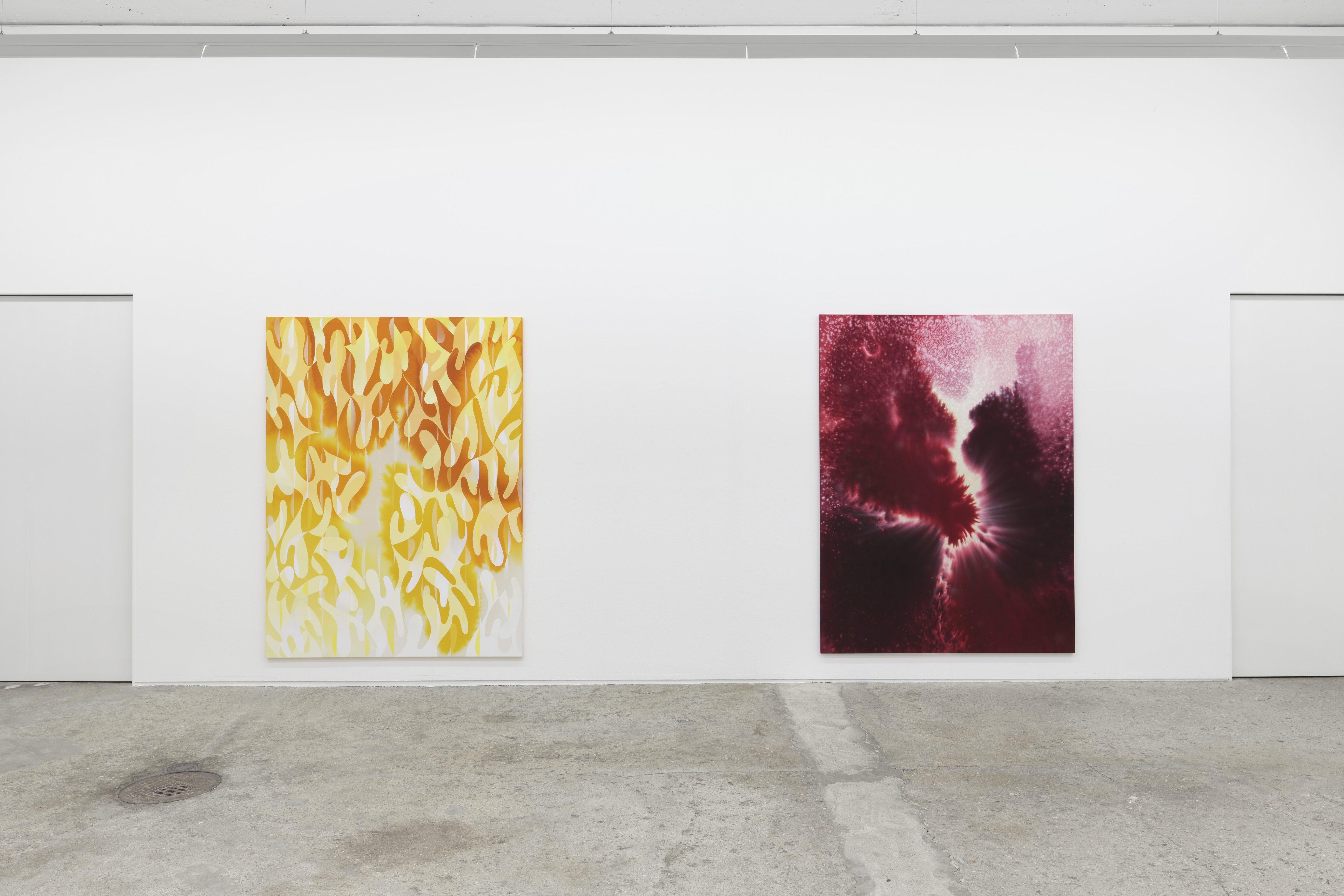
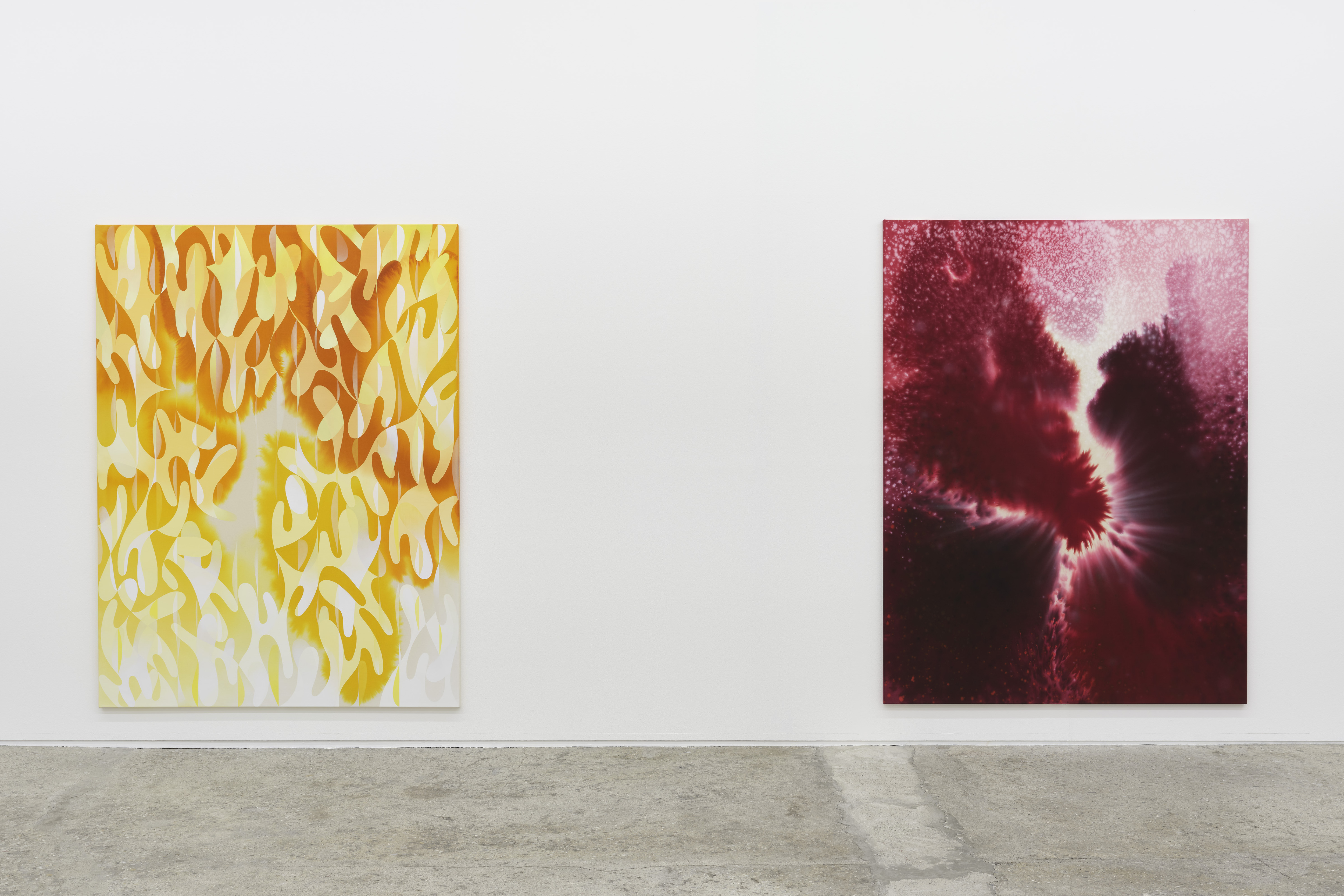
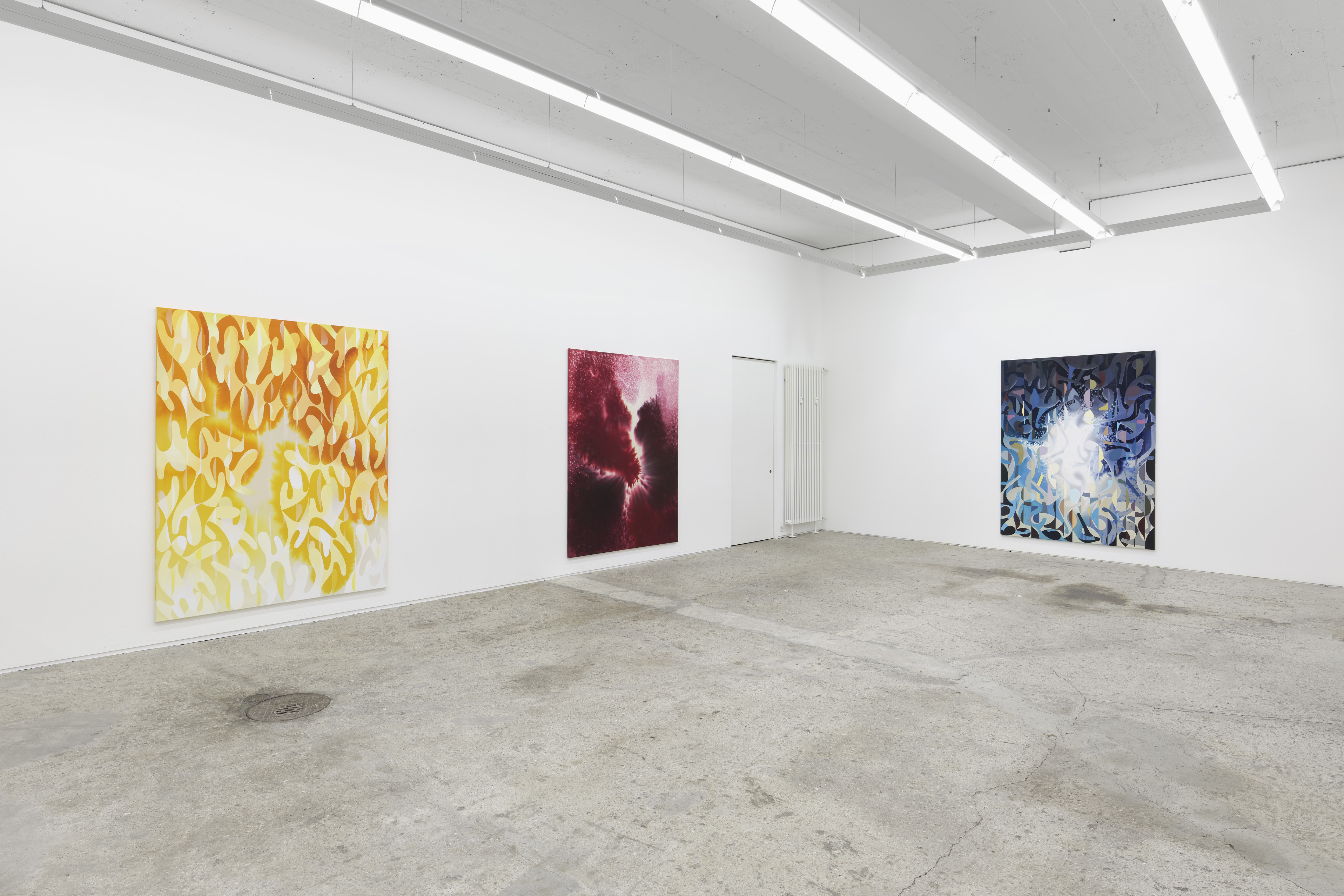
«The artist must prophesy not in the sense that he foretells things to come, but in the sense that he tells his audience, at risk of their displeasure,
the secrets of their own hearts.»
— Robin G. Collingwood
In his 1938 work The Principles of Art, British philosopher, metaphysician, and archaeologist Robin G. Collingwood described the communication of emotion as art’s central task. Art, according to Collingwood, is ultimately an imaginary expression of feelings. From today’s point of view, this statement is not only an overgeneralization and insufficiently explanatory, it also does not apply to all existing art forms. But Collingwood’s theory is revealing because it explains how the power of imagination enables us to communicate feelings in the form of pictures. As a mediating authority between the visual world and reality, it is possible for artworks to reproduce emotion and affect on both levels, to reflect on them and to trigger them.
The works of Giacomo Santiago Rogado also lie between emotional expression and exchange. The exhibition “Kopf Herz Bauch” (Head Heart Gut) shows large and small format paintings by the Swiss artist with Spanish-Italian roots that are intense in their use of color and illustrate the chosen exhibition title in a wide variety of ways. The title refers to three levels of the body that each designate foundational, human qualities: head, heart, and gut are tied to terms like rationality, affect, and intuition. They label essential characteristics and sensibilities that are part of Rogado’s artistic process and the intense visual impact of his works.
Rogado’s mixing technique is based on a system all its own that results from phases that build up on one another. This process-oriented technique is clearly traceable, for in their direct comparison the works reveal their various stages and layers. The crimson red paint in the work Quelle (Source, 2020) shows Rogado’s approach to the untreated visual support. With “chemical intuition,” he lets the spanned cotton be taken by the own will of the paints themselves. The works in the series Accord (2020) show the enormous spectrum of possibilities that builds on the first phase of treatment. By way of stencils, formal fragments are applied with the greatest precision and regularity, condensing the visual surface and reorganizing it. While Accord 7 repeats the same geometric figure with shades of blue-white, the wave shapes arranged vertically in Accord 8 seem to almost to multiply infinitely.
the secrets of their own hearts.»
— Robin G. Collingwood
In his 1938 work The Principles of Art, British philosopher, metaphysician, and archaeologist Robin G. Collingwood described the communication of emotion as art’s central task. Art, according to Collingwood, is ultimately an imaginary expression of feelings. From today’s point of view, this statement is not only an overgeneralization and insufficiently explanatory, it also does not apply to all existing art forms. But Collingwood’s theory is revealing because it explains how the power of imagination enables us to communicate feelings in the form of pictures. As a mediating authority between the visual world and reality, it is possible for artworks to reproduce emotion and affect on both levels, to reflect on them and to trigger them.
The works of Giacomo Santiago Rogado also lie between emotional expression and exchange. The exhibition “Kopf Herz Bauch” (Head Heart Gut) shows large and small format paintings by the Swiss artist with Spanish-Italian roots that are intense in their use of color and illustrate the chosen exhibition title in a wide variety of ways. The title refers to three levels of the body that each designate foundational, human qualities: head, heart, and gut are tied to terms like rationality, affect, and intuition. They label essential characteristics and sensibilities that are part of Rogado’s artistic process and the intense visual impact of his works.
Rogado’s mixing technique is based on a system all its own that results from phases that build up on one another. This process-oriented technique is clearly traceable, for in their direct comparison the works reveal their various stages and layers. The crimson red paint in the work Quelle (Source, 2020) shows Rogado’s approach to the untreated visual support. With “chemical intuition,” he lets the spanned cotton be taken by the own will of the paints themselves. The works in the series Accord (2020) show the enormous spectrum of possibilities that builds on the first phase of treatment. By way of stencils, formal fragments are applied with the greatest precision and regularity, condensing the visual surface and reorganizing it. While Accord 7 repeats the same geometric figure with shades of blue-white, the wave shapes arranged vertically in Accord 8 seem to almost to multiply infinitely.
The works pursue an autopoietic system where different phases remain recognizable due to their independence. But Rogado uses technique, paint, and form in a direct dialogue with one another, a dialogue that results quite intuitively for the artist, but then again vacillates between rational and emotional decisions. The works become an emblem of Rogado’s process and, as it were, mirror the artist himself.
In addition to characterizing the artist’s way of working, the terms head, heart, and gut also say something about the impact of the works. The artist works in the mode of painting, but his works are decidedly unlike paintings in the classical sense. Rogado’s paintings are ambiguous, they do not try to make the real world available to experience on a visual support. There are no fixed criteria of reference, nor is there a defined narrative. The works might seem unapproachable at first, but they are not reticent: instead, they open a space of possibilities in which the picture and the beholder can engage with one another. In this way, the works address the context of painting: they take up the theme of the window as a painterly metaphor and provide a view of something that is found beyond the given visual surface.
Rogado’s paintings are portals in a moment in which standstill and inexorable movement are not mutually exclusive. Often, there is a central point in the picture that captures the searching gaze, slowing it, drawing it inside the picture. In this way, the artist makes a counter proposal to today’s often fleeting visual habits and fixed directions of reading. At the same time, he challenges our longing for explanation and immediacy. A work like Grasp (2020), so filled with shapes and colors (and tellingly created at the start of the first lockdown in the artist’s Berlin studio), is not about being able to reconstruct its visual order. We should allow ourselves to interact the work and explore ourselves as well, as Rogado recently explained in a conversation. “Engaging with my works always means exploring yourself as well. I don’t tell stories or present a strict concept that is easily traced out, but provide a possibility of learning something about yourself.”
The result is a reciprocal relationship between the picture and the beholder: an in- between, or rather a vacuum in which the world slows and other physical laws apply. Though a kaleidoscope of emotions, the gaze is released for the interior of the work, the artist, and ourselves. Quite in Collingwood’s sense, Giacomo Santiago Rogado does not predict the future, but gives viewers an opportunity to reflect on their own feelings in the here and now. Here, we not only listen to our heart, but also to our head and our gut.
Marlene Bürgi
In addition to characterizing the artist’s way of working, the terms head, heart, and gut also say something about the impact of the works. The artist works in the mode of painting, but his works are decidedly unlike paintings in the classical sense. Rogado’s paintings are ambiguous, they do not try to make the real world available to experience on a visual support. There are no fixed criteria of reference, nor is there a defined narrative. The works might seem unapproachable at first, but they are not reticent: instead, they open a space of possibilities in which the picture and the beholder can engage with one another. In this way, the works address the context of painting: they take up the theme of the window as a painterly metaphor and provide a view of something that is found beyond the given visual surface.
Rogado’s paintings are portals in a moment in which standstill and inexorable movement are not mutually exclusive. Often, there is a central point in the picture that captures the searching gaze, slowing it, drawing it inside the picture. In this way, the artist makes a counter proposal to today’s often fleeting visual habits and fixed directions of reading. At the same time, he challenges our longing for explanation and immediacy. A work like Grasp (2020), so filled with shapes and colors (and tellingly created at the start of the first lockdown in the artist’s Berlin studio), is not about being able to reconstruct its visual order. We should allow ourselves to interact the work and explore ourselves as well, as Rogado recently explained in a conversation. “Engaging with my works always means exploring yourself as well. I don’t tell stories or present a strict concept that is easily traced out, but provide a possibility of learning something about yourself.”
The result is a reciprocal relationship between the picture and the beholder: an in- between, or rather a vacuum in which the world slows and other physical laws apply. Though a kaleidoscope of emotions, the gaze is released for the interior of the work, the artist, and ourselves. Quite in Collingwood’s sense, Giacomo Santiago Rogado does not predict the future, but gives viewers an opportunity to reflect on their own feelings in the here and now. Here, we not only listen to our heart, but also to our head and our gut.
Marlene Bürgi
2020
Chameleon
Solo show
Helvetia Art Foyer
Helvetia Art Foyer
4/24 – 6/5/21
Basel
Basel

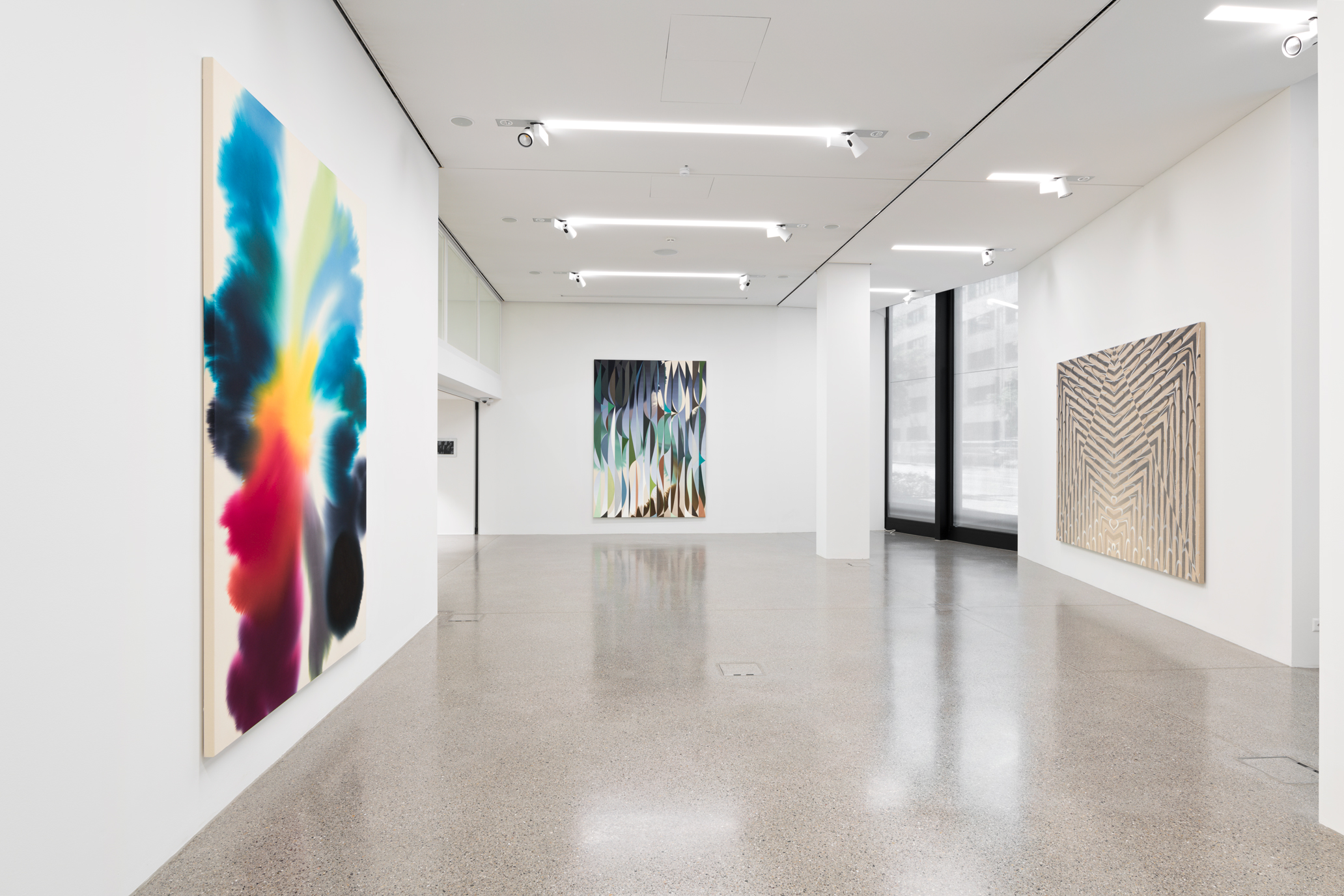


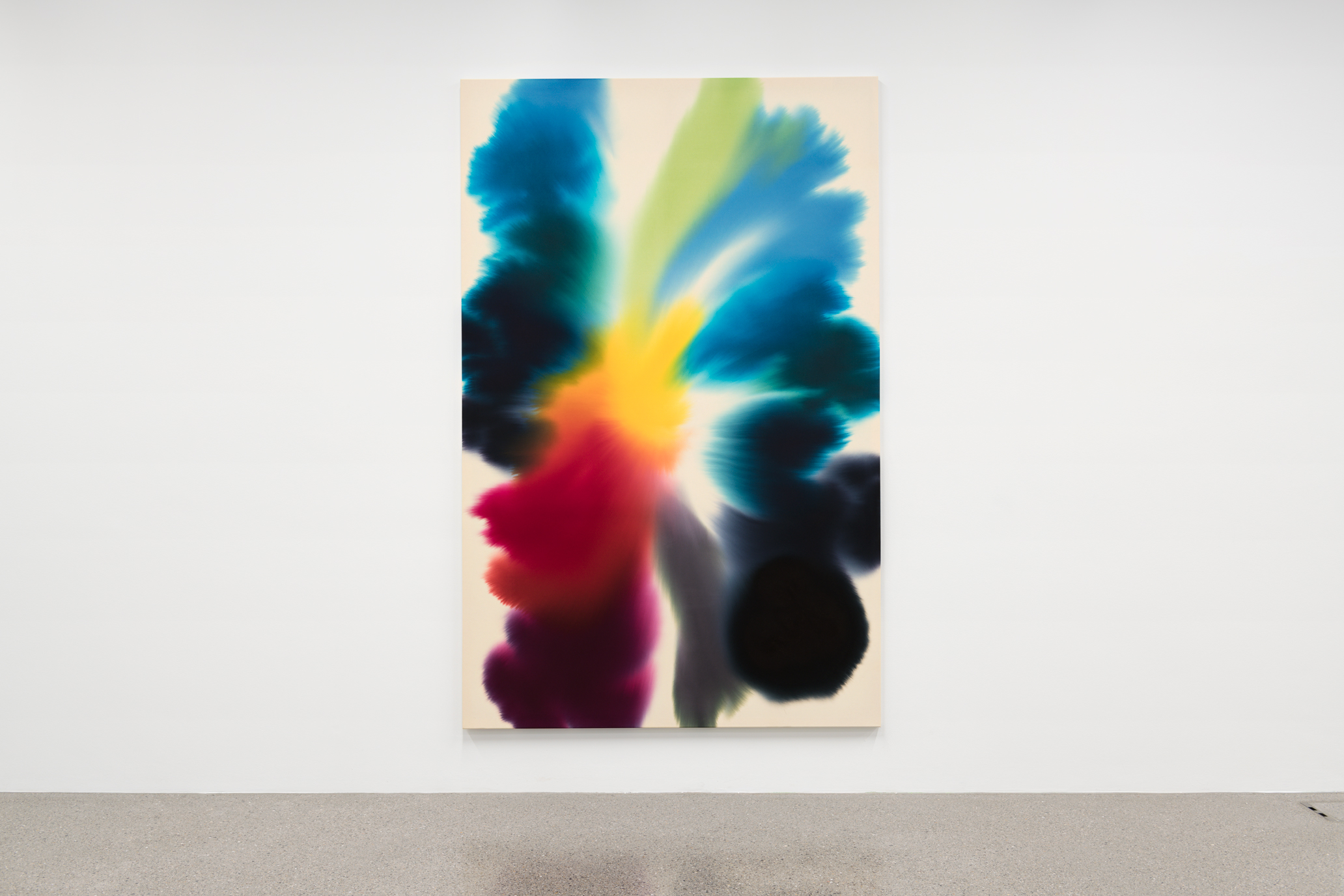



Dass die aktuelle Ausstellung im Helvetia Art Foyer den Namen «Chameleon» trägt, ist keinesfalls weit hergeholt, auch wenn das Tier selbst auf keinem der Bilder direkt abgebildet ist.Chamäleons, die zu den ältesten Reptilien
auf der Erde zählen, faszinieren den Schweizer Künstler Giacomo Santiago Rogado: Bekannt für ihre Tarnkünste und ihr Sichtfeld von 360 Grad, erleben sie die Welt in einem Umfang, den wir uns nur schwer vorstellen können. «Chamäleons [...] liegen mir und meiner Arbeit mit ihren Eigenschaften irgendwie sehr nahe», meint Giacomo Santiago Rogado. Farbenspiele, malerische Effekte und optische Illusionen sind genau im Sinn des in Luzern geborenen Künstlers.
Chamäleons sind Farbenkünstler, doch Giacomo Santiago Rogado hat sich diesen Titel mindestens genauso verdient. Farbenspiele sind sehr präsent in seinen Gemälden, beispielsweise in «Intuition 12» (2014), «Spirit 2» (2015) oder auch «Formación» (2019). Eine Lieblingsfarbe hat der Gewinner des Swiss Art Awards nicht. «Farben sind wie Gefühle, sie kommen und gehen und können unkontrollierbar und überraschend sein – wie beim Chamäleon. Ich liebe alle Farben und könnte mich niemals für eine entscheiden.»
Der Künstler experimentiert gerne und geniesst die unendlichen Möglichkeiten und neuen Kombinationsformen, die sich währenddessen ergeben. Der Künstler versucht sich gerne an neuen Techniken. Alle Werke, die aktuell im Helvetia Art Foyer
auf der Erde zählen, faszinieren den Schweizer Künstler Giacomo Santiago Rogado: Bekannt für ihre Tarnkünste und ihr Sichtfeld von 360 Grad, erleben sie die Welt in einem Umfang, den wir uns nur schwer vorstellen können. «Chamäleons [...] liegen mir und meiner Arbeit mit ihren Eigenschaften irgendwie sehr nahe», meint Giacomo Santiago Rogado. Farbenspiele, malerische Effekte und optische Illusionen sind genau im Sinn des in Luzern geborenen Künstlers.
Chamäleons sind Farbenkünstler, doch Giacomo Santiago Rogado hat sich diesen Titel mindestens genauso verdient. Farbenspiele sind sehr präsent in seinen Gemälden, beispielsweise in «Intuition 12» (2014), «Spirit 2» (2015) oder auch «Formación» (2019). Eine Lieblingsfarbe hat der Gewinner des Swiss Art Awards nicht. «Farben sind wie Gefühle, sie kommen und gehen und können unkontrollierbar und überraschend sein – wie beim Chamäleon. Ich liebe alle Farben und könnte mich niemals für eine entscheiden.»
Der Künstler experimentiert gerne und geniesst die unendlichen Möglichkeiten und neuen Kombinationsformen, die sich währenddessen ergeben. Der Künstler versucht sich gerne an neuen Techniken. Alle Werke, die aktuell im Helvetia Art Foyer
ausgestellt sind, sind mittels Mischtechnik entstanden. Ausprobieren ist ein fester Bestandteil seines Arbeitsprozesses. Neue Ideen kommen Giacomo Santiago Rogado während dem Arbeiten: beim Verwenden von Farben und dem Spielen mit unterschiedlichen Techniken. Frühere Arbeiten des in Berlin lebenden Schweizers sind geprägt von geometrischer Ordnung. Von dieser begann er sich während seiner Entwicklung zu lösen, die Farben flossen freier und unkontrollierter. Dennoch versuchen sich die unterschiedlichen Techniken in seinen Werken gegenseitig stets das Gleichgewicht zu halten.
Das Helvetia Art Foyer ist als Ausstellungsraum anspruchsvoll, es gibt viele Ecken und Fenster, Durchgänge, Säulen und schräg stehende Wände. «Für mich lag jedoch genau darin die Herausforderung. Ich wollte mit wenigen, präzise ausgewählten Arbeiten eine Ruhe in den Raum bringen und einen konzentrierten Blick auf die Malerei ermöglichen. Mit der Auswahl von vier grossformatigen Arbeiten entsteht ein Dialog untereinander, und es eröffnet sich ein neuer Raum zwischen ihnen. Die Reihe von Papierarbeiten hingegen erzeugt durch das kleine Format und den Studiencharakter einen vielleicht intimeren Zugang», erklärt Giacomo Santiago Rogado den Aufbau der Ausstellung.
Mirjam Arnold
Das Helvetia Art Foyer ist als Ausstellungsraum anspruchsvoll, es gibt viele Ecken und Fenster, Durchgänge, Säulen und schräg stehende Wände. «Für mich lag jedoch genau darin die Herausforderung. Ich wollte mit wenigen, präzise ausgewählten Arbeiten eine Ruhe in den Raum bringen und einen konzentrierten Blick auf die Malerei ermöglichen. Mit der Auswahl von vier grossformatigen Arbeiten entsteht ein Dialog untereinander, und es eröffnet sich ein neuer Raum zwischen ihnen. Die Reihe von Papierarbeiten hingegen erzeugt durch das kleine Format und den Studiencharakter einen vielleicht intimeren Zugang», erklärt Giacomo Santiago Rogado den Aufbau der Ausstellung.
Mirjam Arnold